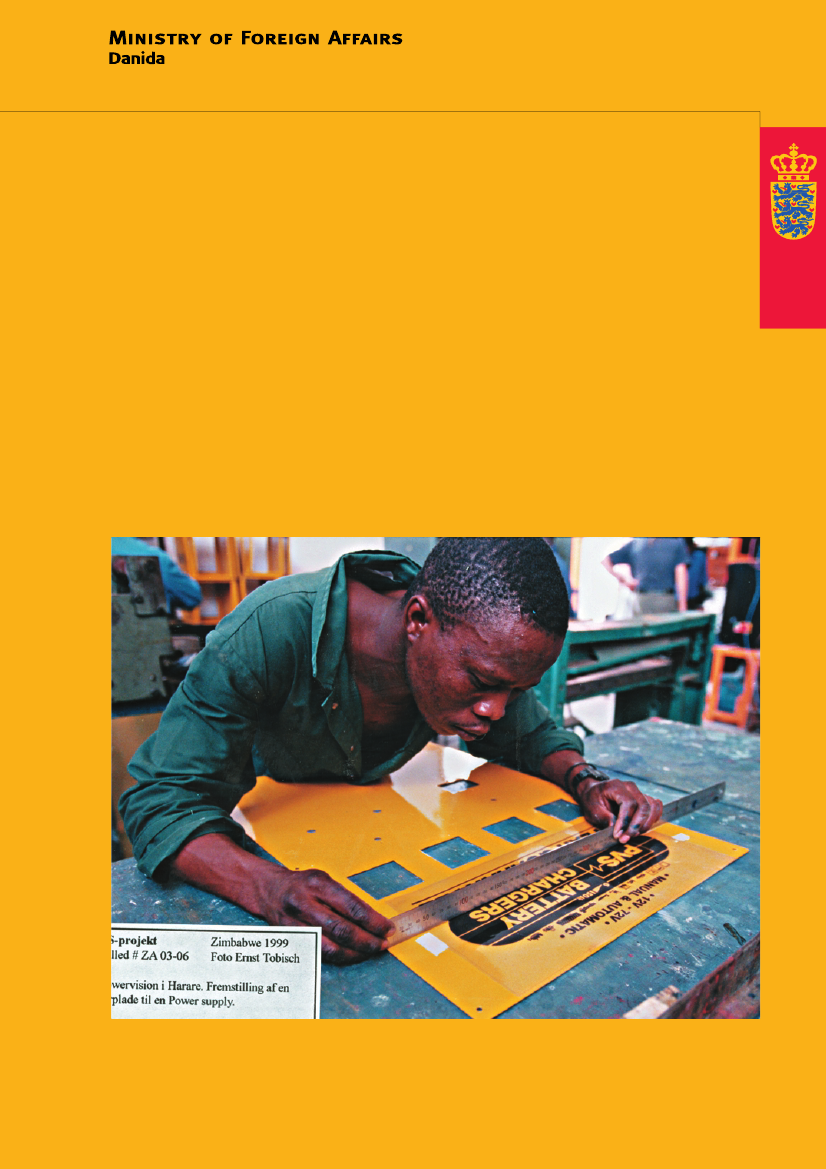Udenrigsudvalget 2008-09
URU Alm.del Bilag 215
Offentligt
EvaluationPrivate SectorDevelopment Programme
2001/1
EvaluationPrivate SectorDevelopment Programme
File No. 104.X.50.Eval.October 2001
Development Associates A/SPlanning, Monitoring and Evaluation
� Ministry of Foreign Affairs, DanidaOctober 2001Production:Cover photo:Design:Print:ISBN:ISSN:Evaluation Secretariat, Ministry of Foreign AffairsErnst TobischDesigngrafik, CopenhagenNielsen & Krohn, Copenhagen87-7964-111-31399-4972
This report can be obtained free of charge by contacting:Bech DistributionHedelykken 2-42640 HedehuseneDenmarkPhone:+45 46 55 01 55Fax:+45 46 55 01 69E-mail:[email protected]The report can also be downloaded through the Ministry of Foreign Affairs’ homepage www.um.dkor directly from the Evaluation Secretariat’s homepage www.evaluation.dk
This report was prepared by independent consultants with no previous involvement in the activities mentioned.Responsibility for the contents and presentation of finding and recommendations rests with the evaluation team.The views and opinions expressed in the report do not necessarily correspond to the views of the Danish Ministry ofForeign Affairs, the recipient governments, or the implementing organisations.The report is printed on Agrippina Star paper and the cover is printed on Invercote, a fully coated folding boxboard.Invercote is manufactured without the use of chlorine.
Table of Contents
Table of ContentsList of AbbreviationsExecutive Summary1. Introduction1.1 Background1.2 Approach and Methodology1.3 Organisation of Evaluation Report2. Direct Programme Results2.1 The Programme in Ghana2.2 The Programme in Vietnam2.3 The Programme in Egypt2.4 Conclusions: Direct Programme Results3. Impact Assessment3.1 Improving Partner Firm Businesses3.2 Private Sector Development3.3 Economic Growth and Social Development3.4 Conclusions: Impact Assessment4. Programme Design and Implementation4.1 Promotion and Awareness of the Programme4.2 Facilitating Private Sector Development4.3 Supporting Business-to-Business Co-operations4.4 Planning and Monitoring4.5 Organisational Set-Up4.6 Conclusions:Programme Design and Implementation5. Towards a New Programme Design5.1 The Programme Re-designed5.2 Objectives and Strategy Re-considered5.3 Enabling Environment Support Re-introduced5.4 More Support Instruments5.5 Organisation and Management ReviewedAnnexesITerms of ReferenceII Evaluation Team and Itineraries237781213131720232727324045474748505356576161626467697175
1
List of Abbreviations
List of AbbreviationsCTADFIDDIDKDKKERSAPEUFDIGDPHVRChief Technical AdvisorDepartment for International DevelopmentDansk Industri/The Confederation of Danish IndustriesDenmarkDanish KronerEconomic Reform and Structural Adjustment ProgrammeEuropean UnionForeign Direct InvestmentGross Domestic ProductHåndværksrådet/The Danish Federation of Smalland Medium-Sized EnterprisesIDAInternational Development AgencyIFUFund for Industrialisation in Developing CountriesILOInternational Labour OfficeIMPIndustrial Modernisation ProgrammeLFALogical Framework AnalysisMPIMinistry of Planning and InvestmentNGONon-Governmental OrganisationPSPrivate SectorPSDPrivate Sector DevelopmentPSFPrivate Sector ForumSMESmall and Medium-Sized EnterpriseSOEState-Owned EnterpriseSPSSector Programme SupportTSATjenesten for Sektorfaglige Anliggender/Technical Advisory ServiceUNIDOUnited Nations Industrial Development OrganisationUSUnited StatesUSAIDUnited States Agency for International DevelopmentVCCIVietnam Chamber of Commerce and IndustryWIDWomen in Development
2
Executive Summary
Executive SummaryThe ProgrammeThe Private Sector Development Programme (the Programme) is part of Danishdevelopment assistance and is therefore subject to the general development objectives:poverty reduction; gender equality; environmental protection and democracy. Theseobjectives are to be achieved by contributing to economic growth and socialdevelopment through facilitating business-to-business co-operations between privatecompanies in the developing countries and Danish companies.The Programme was initiated in 1993 with a three-year test period (1993-1996) inIndia, Ghana and Zimbabwe. The total budget for Phase I was DKK 180 million. An“enabling environment” component was part of the original design.A second phase, for a five-year period (1996-2001) was approved in 1996, adding threenew countries, Uganda, Vietnam and Egypt and abolishing the “enabling environment”component. The total budget for Phase II was DKK 853 million, of which DKK 103million were for administration of the Programme. In 1999, the Programme was expandedto cover an additional five countries, i.e. Bolivia, Mozambique, Nepal, Nicaragua andTanzania. Later same year Bangladesh replaced India as a Programme country.Business-to-business co-operations are supported with technical assistance and financefor the partners to initially visit each other, for special studies required for assessing thescope of the co-operation and for subsequent feasibility studies. A start-up facilitycan also be provided to further prepare the partners´ co-operation and for initialtechnology transfers of up to DKK 0.5 million. Further support can be received undera Partnership project facility, typically up to DKK 3 million.A PS-Secretariat in the Ministry of Foreign Affairs has the overall management andimplementing responsibility. PS-Coordinators manage the PS-Units located at theDanish Embassies in Ghana, Zimbabwe, Vietnam, Egypt, Bangladesh and Uganda.Development Associates A/S was commissioned to undertake the evaluation, thepurpose of which is “..to assess implementation processes and to document resultsof the Programme..”. Three countries were selected for field studies, Ghana, Egyptand Vietnam. The evaluation was undertaken during the period January throughMarch 2001.
ConclusionsOverall ConclusionIn the perspective of the current design the Programme is reasonably successful. It is ingeneral effectively implemented within the designed framework by a competent anddedicated staff. The Programme has succeeded in establishing itself as a recognised partof Danish development assistance and it appears to be highly appreciated by privateenterprises, in Denmark as well as in the host countries.3
Executive Summary
However, the design is very narrowly focused on individual private business-to-businessco-operations with limited concern for broader aspects of development of the privatesector as a whole and for the role of private sector development in overall growth anddevelopment of the respective countries. Consequently, the development impact of theProgramme is limited and less than optimal.Conclusions along these lines are also arrived at in other studies, i.e. in a recentworldwide study by Canadian International Development Agency and in a study of acorresponding EU programme in Egypt. A recent report from the Danish Centre forDevelopment Research also points towards similar conclusions.Direct Programme ResultsThe Programme promotes and facilitates the business activities of Danish companies inthe developing countries concerned. These countries are generally not the preferredcountries for Danish private foreign investments. In spite of this, the Programme hassucceeded in attracting a number of Danish business activities to these countries. Thefocus is on establishing Partnerships between a Danish and a local private company whichare long term, mutually binding and commercially viable co-operations, involving transferof technology to the local partner. The evaluation estimates that, in total, some 90 suchPartnerships have been established by the Programme during Phase I and II.In addition the Programme has financed a number of projects which do not inthemselves entail a longer term mutual commitment. These projects have, however,facilitated transfer of specific technologies over a limited time period and are thus alsoresults of the Programme. Some 115 such technology transfers have been implementedin total, in addition to the approximately 90 longer term and mutually more bindingPartnership projects.During Phase I a number of “enabling environment” projects were also financed underthe Programme. Some of these are still in operation and some have been added duringthe second phase of the Programme. The “enabling environment” component of theProgramme was cancelled after a 1995 Review, except for the loan facility, implementedin Ghana and Zimbabwe only. The Programme facilities have also in Phase II been usede.g. to support co-operations between local and Danish private sector supportinstitutions, i.e. “twinning arrangements”.Impact AssessmentDevelopment impact of the Programme has been assessed at three levels: The immediateobjective is improved local partner businesses, which is assumed to contribute to theintermediate objective: Private sector development, which in turn is assumed to contributeto the development objective of promoting sustainable and socially balanced economicgrowth.In terms of the immediate objective, the Programme has been reasonably successful.The co-operations established have in general resulted in relevant technologies beingtransferred from the Danish to the local partner. Technology transfer is defined toinclude not only specific technical aspects, but also to a large extent organisational,marketing and management aspects. This has contributed to important improvementsfor the local businesses, though many of these face also other constraints limiting the4
Executive Summary
effects and longer term sustainability of the technology transfer. From the point of viewof the local partner the Programme, however, appears rather successful.In contributing to the overall development of the private sectors of the respectivecountries, the Programme is less successful. There are clear direct positive effects onemployment and foreign exchange earning in a number of the individual localcompanies. There are also important cases of improvements in environment and genderaspects in partner companies. However, the project portfolios are generally somewhatdispersed with the projects thinly spread over many types and sub-sectors. There arevery few synergy effects in the portfolios. Opportunities for demonstration anddissemination of experience, of providing “good examples” etc. are typically notexploited. Spin-off effects on other parts of the private sector are thus very limited.The contribution to growth and social development is furthermore limited by a lack ofconcern for the type of private sector development required. Job creation andinternational competitiveness are important for a socially balanced economic growth totake place. Lack of priority criteria implies, however, that the project portfolios are lessthan optimal in these respects. Also the segments of the private sectors being supportedare not necessarily those segments which have the highest growth potential or whichwould contribute most to socially balanced growth processes. The types of enterpriseswhich are supported under the Programme are e.g., not in all cases among the small andmedium sized. In the respective countries, there is no clear relation between this sectorand the support portfolios of the Programme.Positive effects on gender, environment and participation are observed in several projects.They follow from the individual technology transfers and are not the result of asystematic approach or policy in these areas. There is no explicit strategy for how toapproach these concerns in the contexts of the individual countries.Towards a New Programme DesignThe conclusions above suggest that continuation of the Programme should be conditionalon a major re-design to give it a clear development profile. Chapter 5 presents theevaluation findings in this respect, which are broadly in line with Danida’s new ActionPlan for Business Sector Development. A new design must consider the appropriatenessof the objectives and strategy in the contexts of the individual countries. It needs toinclude possibilities for a broader and integrated support to private sector developmenti.e. “enabling environment” components. More instruments should be available. Areview of the current organisation and management is also required. Chapter 5 givesdetails concerning the recommendations made below but does not claim to be exhaustive.
RecommendationsIt is recommended that Danida takes action towards:The Programme Re-Designed•Programme to become spearheadfor Danish private sector support in countries wherethe Programme is well established. Though the Programme shall not itself address allconstraints, it shall ensure that the Danish support provided in these countries iswithin a comprehensive private sector support framework.5
Executive Summary
•Country strategiesto be developed for each of these countries as a means to designingthe Danish support in relation to potentials and constraints for private sectordevelopment and in coordination with other donor support.Objectives and Strategy Re-Considered•Objectives reformulated,to include private sector development and overalldevelopment objectives and to ensure that the Programme has a clear developmentprofile.•Strategy formulated,to reflect the new design. The “from below” and business-to-business approach shall be maintained, but in a broader private sector developmentperspective.Enabling Environment Support Re-Introduced•Private sector institutions,supported to enable them to assist local private businesses,relieving the PS-Units from part of their present activities in this respect.•Training institutions,supported to ensure sustainability and dissemination of effects.This can be visualised in sub-sectors, where a number of projects are implemented.•Labour market institutions,supported to ensure appropriate labour marketdevelopments. Experience from individual business-to-business co-operations whichare “good examples”, to be disseminated.•Financial institutions,supported in country specific context of financial system. Thisis to address an often very important constraint of lack of long-term investmentcapital.More Support Instruments•Preparatory facilities expanded,to include enabling environment and context analyses,for developing the country strategies and to design the specific instruments in therespective country contexts.•Start-up facility reviewed,to ensure adequacy and flexibility.• Partnership support reviewed, to ensure adequacy and flexibility, building on pastexperience of the Programme.•Loan facility in all countries,designed as support to, and in the context of, existingsystems and in accordance with the Danida “Guidelines for Support to FinancialServices”.•New instruments developed,as part of overall Programme design for new interventionareas, but specifically designed for the respective countries in the country strategies.Organisation and Management Reviewed•PS-Coordinators,broader responsibilities towards private sector development and forensuring the development profile of the Programme in the specific country context.•Outsourcing,of parts of PS-Unit activities, e.g. to private sector institutions whichprovide private sector support of similar nature.•Consultant support reviewed,to strengthen the project preparation process in order toincrease the efficiency of the “dialogue” between the partners concerning the natureand modalities of co-operation.
6
1. Introduction
1. Introduction1.1. BackgroundThis report is the result of an evaluation study of the Private Sector DevelopmentProgramme under Danish development assistance to developing countries. The studywas undertaken in the period January through March 2001.The Evaluation Team wishes to express its appreciation of the courteous and efficientassistance received from the PS-Secretariat, the PS-Coordinators, staff of the PS-Unitsand the staff of the firms and institutions interviewed. The views expressed in thisreport are those of the Evaluation Team and thus do not necessarily correspond to theviews of the governments of the respective countries or of the Danish Ministry ofForeign Affairs.The PSD ProgrammeThe Private Sector Development Programme (the Programme) was established in 1993in the three countries – Ghana, India and Zimbabwe – for a three-year test period. Thetotal budget for the three countries was DKK 180 million. Towards the end of the firstphase in 1995, a review was undertaken. The review recommended an extension andexpansion of the Programme.Based on these recommendations, Phase II of the Programme was approved for a five-year period (1996-2001) with a total budget of about DKK 853 million, of whichDKK 103 million were for the administration of the Programme. At the same time, thenumber of countries included in the Programme was increased to include Egypt,Uganda and Vietnam.A second review was undertaken in 1999. A further expansion of the Programme wasrecommended and five new countries were included, Bolivia, Mozambique, Nepal,Nicaragua and Tanzania. Later in the same year Bangladesh was included as areplacement for India.The purpose of the Programme is to contribute to economic growth and socialdevelopment through support to the establishment of business-to-business co-operationbetween private companies in the developing countries and Danish companies.Establishment of business-to-business co-operations is supported with technical assistanceand finance for the companies to initially visit each other, for special studies required forassessing the scope of co-operation and for subsequent feasibility studies. A start-up facilityis also available to the partners to further prepare their co-operation and for initialtechnology transfer. Further support can also be received under the Partnership projectfacility.A PS-Secretariat at the Ministry of Foreign Affairs in Copenhagen has the overallmanagement of, and responsibility for, implementing the Programme. In each of theoriginal Phase II countries (with India replacing Bangladesh) there is a PS-Unit, headedby a PS-Coordinator. In addition there is an agreement with the Association of Danish7
1. Introduction
Industries (DI) and the Federation of Small and Medium-sized Enterprises (HVR) forproviding assistance to the matchmaking procedures. There are also funds allocated forhiring external consultants (national and international) to assist with the projectpreparatory work.PS-Coordinators are employed on a contractual basis. They generally have a technical orfinancial background and experience of private business operations in developing countries.Purpose of EvaluationIn connection with the approval of Phase II, it was decided that an evaluation should beundertaken towards the end of the period. Hence this evaluation was undertaken.It should be emphasised that an evaluation is different from a review. Generally, thelatter focuses on effectiveness of implementation and design relative to the specificobjectives of the project or programme concerned. These objectives are not normallyquestioned as part of a review, whereas evaluations typically go a step further. Anevaluation will normally assess the impact of the project or programme in relation tothe broader objectives underlying development assistance. Hence an evaluation canquestion whether the specific objectives of the project or programme are relevant andwhether the implementation and design are effective in relation to the developmentobjectives of Danish development assistance.The specific purpose of the evaluation is formulated in the Terms of Reference (attachedas Annex 1) as “…to assess implementation processes and to document the results ofthe Programme in order to provide background information for expanding or revisingthe Programme.”This formulation is interpreted to entail that the impact of the Programme shall beassessed against the objectives for Danish development assistance as well as against thespecific objectives of the Programme itself.
1.2
Approach and Methodology
The study has been undertaken in three main phases, partly overlapping, because of thetight time frame for completing the study. The first phase was a desk study phase, duringwhich the material available in the Programme files in Copenhagen was scrutinised andanalysed. During this phase, an “Issues and Methodology Paper”, outlining anddiscussing issues, approaches and methodologies, was also drafted.A second phase comprised the fieldwork in the three countries selected: Ghana, Egyptand Vietnam. These three countries were selected because they have relatively largeproject portfolios, which make impact assessments meaningful. Furthermore, the threecountries are from different parts of the world and they illustrate the spectrum ofdifferences in the countries in which the Programme is implemented. During this phase,the deskwork was continued in each of the three countries since as a considerable partof the relevant information is only available in the PS-Units of the respective Embassies.In each country visited a debriefing note was drafted and discussed with the ambassador,the PS-Unit and with embassy staff. Staffing and itineraries for the country fieldworkare to be found in Annex 2.8
1. Introduction
The last phase is the synthesis, analysis and reporting phase. The core team andparticularly the coordination team have been responsible for drafting this evaluationreport. Informal contacts and discussions with the PS-Secretariat have been part of thisprocess as have the discussions undertaken during the fieldwork, in which representativesof the PS-Secretariat have participated as resource persons.Evaluation ApproachThe evaluation results presented in the following chapters are mainly based on theassessments and analyses of the implementation of the Programme in the three selectedcountries: Ghana, Egypt and Vietnam. In each of these three countries, a sample ofstart-up facilities and Partnership projects has been selected for deeper analysis andinterviewing during the fieldwork phase. The total number of these two categories ofprojects in all the countries currently included in the Programme, as well as the samplenumbers, are shown in Table 1 below:
Table 1: Project Sample and Total Projects ApprovedPr. 21 Dec 2000. Phase I and II.CountriesStart-up facilitiesSampleTotal0770000018032 (15%)319412312-335432208PartnershipsSample07100000010027 (17%)
Total2143051-1292028157
BangladeshEgyptGhanaIndiaNepalMozambiqueTanzaniaUgandaVietnamZimbabweTotalSource: PS-Secretariat
For each project visited during the fieldwork, a “Project Profile” has been produced.This has formed the basis for the analyses of the effects of the Programme on theprojects sampled in each country. This sample information has been supplemented withinformation contained in similar profiles (though with less information) for theremaining parts of the project portfolios in these countries. Thus some of the results,particularly those based on qualitative assessments, are based on the project sampleswhereas the statistical information provided in the following is often based on the fullproject portfolio of the respective country.In selecting the project samples in the three countries, efforts were made to cover broadlydifferent types of co-operation and different sectors. These analyses and selections weremade as part of the deskwork phase. Establishing the basic information contained in the9
1. Introduction
projects profiles, for projects not included in the project samples, was part of the deskworkthat continued the fieldwork in the respective countries.Assessment MethodsThe methodology used for assessing impact is basically the “cause-effect chain” method.This method requires a specification of the “objectives hierarchy” and an identificationof assumptions, which are judged crucial for one step in the chain to lead to the next.Assessments of the validity of these assumptions are then made. The objectives andassumptions used are outlined and discussed below.Potentially crucial assumptions were identified as part of the deskwork and this hasguided the fieldwork. The list of such assumptions is large and, in practice, some turnout to be more relevant than others. Country differences are clearly also important inthis context. Under the general guidance mentioned above, each country team has madeits own assessment of which assumptions were the most relevant in the specific countrycontext. Assessing the validity of the assumptions has also been undertaken by thecountry teams, supplemented by the observations of the coordination team.The interviews undertaken with the individual firms in the project sample are the mainbasis for these assessments. In addition, a number of interviews were conducted by thesocial anthropologist of the coordination team in all three countries. These focused onsocial aspects and training and covered firms which have received the three different typesof support i.e. study visits, start-up facilities and Partnership projects. Though those inter-viewed were primarily managers, some employees were also included. General informationabout the private sectors and of the support of other donors was also collected. Further-more, statistical analyses pertaining to the part of the portfolios which are not part of theproject sample in the respective countries, provide supporting data for the assessments.In assessing the effect of the sample projects six basic criteria have been used, thoughnot to the same extent in all three countries, because of the different contexts andconditions. The criteria are:••••••employment generationforeign exchange earningstechnology relevanceenvironmental improvementssustainabilityadditionality
The first two criteria are considered key constraints in most developing countries andthe evaluation supplements the analyses of the project samples with an analysis of thewhole project portfolio in each of the three countries. This analysis assesses the likelypositive net contribution to job creation and increased international competitiveness ofthe private sectors and is based on an assessment of the types of technology beingtransferred under the Programme.Technology transfer is the essential component of the expected contributions of theProgramme to improved businesses of the local partners. Relevance of the technology isassessed both in relation to the individual local partner businesses and in relation to thesector/industry and country as a whole.10
1. Introduction
The environmental improvement criterion focuses on the environmental effects of thenew technology. The assessment relates to external as well as working environment. Inmany cases the new technology affects both and it is often impossible to assess thesetwo aspects separately.Sustainability concerns primarily sustainability of the technology transfer. It is generallyjudged on the basis of financial performance of the improved business of the local partnerfirm. Information on this has not been readily available in all countries, however, andthere is a large element of judgement involved.Additionality is also a difficult criterion to use. It refers to the question of whetherobserved effects on local firms have been caused by the Programme. There are caseswhere the co-operation would have taken place also without Programme support. Insuch cases the Programme has not had impact. Though difficult to apply, the criterionis important, as the Programme is intended as an incentive to firms, which would nototherwise establish co-operations in these countries.The six criteria covers the nine aspects mentioned in the Terms of Reference underScope of Work. The “enhanced competence” and “savings in production inputs” areessential elements in assessing the relevance of technologies being transferred. The twoenvironmental aspects are combined, as mentioned above, for practical reasons. The“spin-off ” effects is not specified as one specific criterion, but these effects are assessedas part of the impact assessment.Objectives and AssumptionsThough there are various formulations of the objectives of the Programme, contributionto economic growth and social development by the establishment of long-termPartnership co-operation is the basic idea.For an impact assessment to be made, using the above-mentioned method, a hierarchyof objectives needs to be established. In what follow, the development objective thatreflects overall Danida objectives, is taken to be “a contribution to a sustainable andsocially balanced economic growth process”. The immediate objective is specified as“improved business of local partner”. In addition to these two objectives only anintermediate objective of “private sector development” is specified. The output or directresults of the Programme are “Partnerships established”.This is a very general objectives hierarchy and the assumptions are correspondinglygeneral but indicates three levels in the impact assessment.The first level is the immediate objectives level. It concerns impact on the individual firmsin the host countries that are engaged in co-operation with a Danish partner, and support-ed with either a start-up facility or a Partnership project (or in a limited number of cases,both). For this support to have positive impact at this level, crucial assumptions relate toeffects on turnover, production costs or, more generally, to profitability. There are similarlyimportant assumptions relating to effects on employees’ occupational health and safety;working conditions; environment; gender aspects and participation in decision-making.At the next level, the intermediate objective level, the general assumption is that improvedlocal partner businesses automatically imply private sector development of the respective11
1. Introduction
countries. This assumption is not universally valid. What is good for an individualcompany is not necessarily good for the country as a whole. Furthermore, one cannot ingeneral assume that the aggregate effect of a number of individual projects is equal to thesum of the individual effects. Externalities, spin-off or dissemination effects are examplesof effects, which are not captured, in a simple summing up. Thus, the extent to which theProgramme contributes to the development of the private sector needs more analyses thanthat of the benefits to individual companies.Finally, there is a general assumption that private sector development will contribute tothe growth objective specified above. This assumption is not automatically valid either.There are aspects of private sector development, related first of all to equality and socialdimensions, which do not emerge sui generis in a market economy.
1.3
Organisation of Evaluation Report
Chapter 2of this report is devoted to an analysis of the Programme in terms of its directresults, i.e. the establishment of business-to-business co-operations. It gives a descriptionof the Programme in the three countries visited and a summary of the overall numberand forms of co-operations established under the Programme.Chapter 3is the impact assessment chapter, undertaking the assessments indicatedabove at the three objective levels. This Chapter thus purports to be the chapter whichassesses the development impact of the Programme. This is done in terms of theobjectives hierarchy specified above and appears to be in accordance with the generalspecification of the Programme’s own objective.Chapter 4identifies a number of issues related to the design and implementation of theProgramme.Chapter 5discusses the evaluation findings in the perspective of a proposed future re-design of the Programme.
12
2. Direct Programme Results
2. Direct Programme Results2.1. The Programme in GhanaPrivate Sector Prospects and ConstraintsSince the Programme started in Ghana in 1993 the industrial sector and the manufactur-ing sector in particular, has experienced a low rate of growth. The macro-economicenvironment for private sector development has become less conducive. Government’sincreasing domestic borrowing has resulted in crowding out private investments and bankinterest rates are now around 50 per cent.The financial sector has thus not been in a position to provide the private sector withshort or long-term credit. From the end of 1999 to the middle of 2000, the exchangerate of cedi to dollar more than tripled. This hit the whole industrial sector hard. Thesteep depreciation further fuelled the inflation rate, now reaching 40 per cent per year.For example, prices of manufactured goods have tended to increase more than fooditems. With an overall low rate of growth in the economy, the relative price increase inmanufactured goods has further depressed domestic demand for these goods.There has been some liberalisation of the economy and policy efforts have been made tostimulate non-traditional exports, particular in the “Green Gold” sectors related toagriculture. Industrial development continues to be dominated by import substitutionand is heavily dependent on imported raw materials and equipment. Institutionalreforms in port handling and custom free zones have had some impact. But bothdomestic and foreign investment in the private sector remain low.The rather slow private sector development, particularly in the manufacturing sector, meansthat the actual number of firms in the organised manufacturing sector is low. Figures fromthe VAT-register suggest that there are only around 1700 to 2000 firms. Although theProgramme is not confined to the manufacturing sector, this nevertheless suggests that thenumber of potential Ghanaian Partnership firms is very limited. Some of the largestmanufacturing companies are foreign multinationals. Ownership of medium to large scalefirms is, in some basic industries, dominated by the Lebanese and Indian communities.Infrastructure for private sector development in Ghana has improved over the yearsparticularly in the transport sector. It is better than in some other African countries.However, the infrastructure is still very fragile and causes serious production problemsfor private firms in areas such as electricity and water supply and the provision oftelecommunication services.The institutional and regulatory framework is also often quite cumbersome for privatebusiness. But, for trade and industry, there have been efforts towards capacity building andimproved efficiency in the bureaucracy. There often appears to be a lack of coordination,sound administrative procedures and equipment to undertake efficient monitoring.Harbour administration has improved. But other public services and regulatory institutionsdo not appear to be much client-oriented. Corruption is also said to spread. However,independent of macroeconomic conditions, there are several areas in which institutionalimprovements could be made that would facilitate private sector development.13
2. Direct Programme Results
Until late 2000, the Government was not particularly friendly to domestic private sectorentrepreneurs. Their businesses could be rather arbitrarily affected. Private businessowners tended to lower the political risk by spreading their investments. The newpresident and his government are expected to be more private sector friendly. But firstof all they have to take rather unpopular budgetary policy measures to give room formore private sector investments.Other donors than Danida have provided substantial support to private sector developmentin the past (including the World Bank and the United States Agency for InternationalDevelopment (USAID)) and some is still ongoing (USAID and the Department for Inter-national Development (DFID)). Support is typically in the form of projects providingmore or less comprehensive packages of assistance to SME development.The experience of past private sector assistance is not encouraging as the impact seemsvery limited. This appears to be due primarily to two factors: the deteriorating macro-economic situation and the political climate. Though some improvements are noted(e.g. increased exports), Ghana’s productivity levels are still very low and labour skilllevels need substantial upgrading in many areas.Several donors are committed to continued support to private sector development. Withthe new Government, the general conditions for private sector development are expectedto improve. The support will be of the same general nature as indicated above. Thespecific form of the Danish business-to-business approach is a unique form of donorsupport in Ghana. Some other donors do, however, have certain instruments which aresomewhat similar.Programme in ContextGhana was included in the first phase of the Programme (1993-96). In addition to thebusiness-to-business grant facilities, the Programme included a loan component andsupport to enabling environment activities. In the second phase, support has only beengiven to one enabling environment activity: that between the Federation of DanishIndustries and the Association of Ghana Industries.The approved allocations for start-up facilities and Partnership projects in Phase I, wereDKK 2.6 million and DKK 27.6 million respectively. In Phase II the approved allocationsto projects have been DKK 93.6 million. Detailed figures are given in the table below.
Table 2. Ghana: PS-allocations (approved grant (loan)Phase INumberPartnershipsStart-up facilitiesTotalSource: PS-Unit Ghana10 + 1 extension616 + 1 extensionPhase IINumber
DKK 100027,5602,57030,130
DKK 1000
20 + 2 extensions 75,80035 + 1 extension17,76055 + 3 extensions 93,560
14
2. Direct Programme Results
Support has been given to 197 partner visits, 50 feasibility studies and 30 specialstudies.The allocations for Ghana in Phase II amount to about 21 per cent of the totalallocations made under the Programme. However, the figures for Ghana include theamounts allocated under the loan facility, which is only implemented in Ghana andZimbabwe.Disbursement for Phase II has been DKK 72 million but have varied in recent years asfollows:
Table 3. Ghana: Programme Disbursements 1998-20001998DKK 1000Visits (Ghana + DK)Special + feasibility studiesMarketing of the ProgrammeConsultant feesPS-Projects (Start-up and Partnerships)TotalSource: PS-Unit Ghana9762,6099538611,88215,9481999DKK 10009892,4545459721,30125,3952000DKK 10001,3493,1914792714,53620,050
The figures in the table do not include staff salaries and current costs of the PS- Unitfunded by the Programme. Furthermore, consultant expenditures in Denmark to startand prepare projects in Ghana are not included. While there has been a tendency forpreparatory activities and consultancy to increase, the disbursements to projects – thatis, i.e. start-up facilities and Partnerships – have fluctuated. Danida’s total disbursementsin Ghana, including the Programme, were DKK 308 million in 2000. Hence theProgramme constitutes around 6-7 per cent of project disbursements.Sectorwise, there is some concentration on the fishery and wood/furniture industries.But, as the following table shows, the projects have been spread over many sectors:
15
2. Direct Programme Results
Table 4. Ghana: Approved Projects. Phase I & IISectorStart-up facilitiesNo.GrantDKK 100034481117381,5002,0001,9604,0005005008,38018,840PartnershipsNo.GrantDKK 100023651673014,29012,04014,39014,9405,79017,13026,270104,850TotalNo.
GrantDKK 100015,79014,04016,35018,9406,29017,63034,650123,690
Agro-industryTransport infrastructureFisheryWood & furniturePharmaceuticalEnabling environmentOthersTotal
571013272468
Note: In cases where the partners have received grants for both Partnership and start-up facility,the sum of the two is placed under Partnerships
Except for a few cases, partners in Ghana are small and medium size firms. Taking intoconsideration the depressed situation in the private sector, only a couple of the largest firmscan be assumed to acquire the technology on commercial terms. With the availability of theloan facility to fund equipment investments, the input of the Programme has, in a largenumber of cases, played a dominant role for the firm’s production capacity and financialsituation.The Danish partner profile also varies. But with a couple of exceptions, it is dominatedby very small or medium size firms. Most of these firms have not selected Ghana as alocation for strategic reasons but, given PS support, consider Ghana to be an interestingbusiness opportunity. In a number of cases, projects have evolved out of older Danishbusiness interests in Ghana that had suffered under the economic depression.Under both the start-up facilities and Partnership projects there are cases in which,shortly after approval, projects have been cancelled or co-operation has been terminatedafter funds have been utilised and investments made. Generally speaking, the reasonsfor this are invalid assumptions or disagreements between the partners. This has in somecases resulted in substantial investments lying un- or underutilised. Joint ventures haveto, a large extent, been used as a form of long-term co-operation. But, in both phases,experience shows that such projects can also fail.There has been 41 start-up facilities approved and 17 of these are ongoing. Of the rest,three have continued into Partnership projects while another three are applying for suchand are included in the Partnership pipeline. Some of the remaining have been fullyimplemented; occasionally with some continued partner contact. Others have beencancelled after approval.The Loan FacilityIn Ghana, a number of loans have been provided to Partnership projects. But repaymenthas been very bad. Loans are handled by the PS-Unit and disbursed from the embassy.16
2. Direct Programme Results
The loans are then given over to a bank, which against a fee shall collect repayments.Funds collected are to be paid in to the Treasury, as Danida funds are grants to theGovernment. The fact that the funds are known to be government or donor money is onereason why repayment performance is so bad. The bank can take legal action againstdefaulters. But that is a costly affair, likely to involve a loss for the bank. The bank’sinterest in pursuing such strong measures is thus limited.AdministrationThe PS-Unit is located in the Danish Embassy where the PS-Coordinator is assisted bya project officer, an assistant project officer and a secretary who is occasionally sharedwith the Embassy. The unit has a heavy administrative burden running the Programmeand has to respond to a very large number of external enquiries. Local consultants areextensively used, both in the preparation and monitoring of activities. Close links aremaintained with external institutions of which, in particular, Empretec – supportinstitution for SME development – has been involved. Presently the unit has aworkload above its capacity level. This results in an administrative bottleneck.The PS-Coordinator finds that there has been a learning process over the years in whichcareful planning and Partnership commitment is increasingly emphasized. By the end of2000, the project pipeline contained 32 projects of which several fall within the “GreenGold” sectors which now includes agro-processing projects. The Coordinator, however,finds that there is no reason to exclude good projects that fall outside these sectors.
2.2. The Programme in VietnamPrivate Sector Prospects and ConstraintsSince independence in 1945, Vietnam has followed a socialist path according to which thepublic sector is the centre of society. During 1960-80, heavily influenced by Chineseand Soviet policies, the Vietnamese Government tried to eliminate the private sector.Government policy started to change after the introduction of the Doi Moi (Renovation)in the late 1980´s, and gradually became more positive to private sector development.Even though Vietnam remains dominated by large state-owned enterprises (SOEs),especially in what is seen by the Government as “strategic” sectors such as heavyindustry, private sector development is rapidly increasing in most other sectors. Despitewidespread red tape, the private sector has manifested its role as a leader in economicdevelopment, enjoying high output growth rates.Until recently, problems have been considerable for joint ventures with foreignpartners. Until 1999, many foreign partners of larger joint ventures tried to eitherwithdraw or to take over the business totally. This was mainly a consequence ofdifficulties in reaching a common understanding of, and practice in, businessoperation and financial manoeuvres. As a direct consequence of this, the DanishEmbassy did not actively promote Danish company involvement in joint ventures. Thishas, naturally, had an effect on the development of equity-based Partnerships under theProgramme. The foreign business climate is now improving, and a major Danish-financed joint venture will be carried out under the Programme in 2001. It is expectedthat two more joint ventures will be eligible for support in 2001.17
2. Direct Programme Results
In the private sector, trade policy and baking, the government’s ongoing reformmeasures have picked up momentum. A more liberal Enterprise Law came into effect in2000, generating a strong response from the private sector in terms of new registrations.With international assistance, a detailed SOE reform plan has been developed and hasnow been submitted to the leadership for approval. However, based on past experience,the reform is likely only to proceed at a slow and cautious pace.The reform momentum has also profited from the fact that normalisation of US traderelations now only awaits the US Government’s ratification. A stock exchange opened inHo Chi Minh City in August 2000. Finally, it is likely that, as from 2001, communistparty members are officially allowed to own and operate private enterprises.After a few years of slow growth, mainly as a consequence of the Asian financial crisis,Vietnam is now enjoying higher and industry-led growth rates of 6-8 per cent. It isforecasted that Foreign Direct Investment (FDI) is expected to be at levels comparableto the pre-crisis figures; there will be increasing export growth (27 per cent) and zeroinflation as a consequence of falling food prices. Interest rates are down at 7-8 per centand, compared to the last decade, credit supply seems a less serious constraint.Thus the macroeconomic framework is now increasingly positive to private sectordevelopment. Although private sector development remains constrained by lack ofmanagement and international marketing skills, Vietnam’s labour force is well educated,entrepreneurial, and hard working, and wages are competitive.The Programme in ContextThe Programme in Vietnam started early 1997. Approvals and disbursements are asfollows:
Table 5. Vietnam: Approvals and Disbursements. Phase IITotalNo.SampleNo.ApprovedDKK 1000
ApprovedDKK 10003,0352,1355,9999,50826,38740,29287,356
DisbursedDKK 10002,5031,9345,4828,77921,90517,21157,813
of whichSOEs
Visits to VietnamVisits to DKSpecial studiesFeasibility studiesStart-up facilitiesPartnershipsTotal
1669943395418419
18*1028
8,94125,005
105
Source: Annual Report of the Programme*) Six of the visited Partnerships have also made use of the start-up facility
As the total number of matchmaking activities indicates, interest in the Programme has beenconsiderable. A relatively large number of start-up facilities suggests that the Programme and18
2. Direct Programme Results
Danish companies have preferred to test co-operation possibilities before engaging in moreformalised co-operation agreements. However, only seven of the 54 start-up facilities have sofar developed into Partnerships. A high proportion of the Partnerships (10) were approvedin 2000, illustrating the fact that, to reach final project stage, the programme process takestime, and that only after three years of operation do “real” projects start to materialise.Given the somewhat special circumstances of the Vietnamese economy, Danida chose abroader definition of the private sector and allowed SOEs to participate in the Programmein Vietnam. As a consequence, the Programme in Vietnam was promoted as a businessdevelopment programme during the first years i.e. not solely directed at the private sector.This is partly because a programme targeting only private companies was judged to bepolitically sensitive. It was also anticipated that there would be positive externalities in theprivate sector as a result of this support and that successful SOEs would be more likelyto be privatised. About half of the projects visited were SOEs.
Table 6. Vietnam: Sectoral distribution of PS-projectsSectorsSeafood and marineWood processingTextile and garmentTourismManufacturingConsultingWater supplyOtherTotalStart-up facilities155421174654Partnerships5-31341320Total2057314115974
The largest sectoral concentration in Vietnam has been in the seafood and marinesector, with 15 start-up facilities and five Partnerships. Manufacturing (mainly in lightmetal industry) and consulting (mainly in water supply, environment and ship design)are also two large Programme sectors. The PS-Coordinator is presently working todevelop a pipeline in the plastic and IT sectors.44 start-up facilities that expired in 2000 or earlier have recently been closed down bythe PS-Coordinator. In addition, two Partnerships were cancelled in 2000 due to poorperformance. This leaves 10 ongoing start-up facilities and 16 ongoing Partnerships.The Vietnamese Government is not directly involved in the implementation of the Program-me. The Ministry of Planning and Investment (MPI) is not involved in the Programmebecause Danida wanted to underline the business-to-business character of the Programme.Thus there is limited dialogue with the government on the implementation issues.The Programme has tried to build up co-operation with a number of organisations andinstitutions. Traditionally, all organisations are government-controlled and financed. Yetmany institutions and organisations are now gradually enjoying a higher level of19
2. Direct Programme Results
independence and increased PS co-operation with such institutions and organisations isbecoming more meaningful. One important exception is the Vietnam Chamber ofCommerce and Industry (VCCI) which, by private sector participants, is considered tobe a government-appointed representative of the business sector.Another body is Vicoopsme (Vietnam central council of Co-operatives and SMEs), whorepresents co-operatives and small and medium private enterprises. The organisation isbureaucratic and has limited capacity. The German Technical Co-operation Agency(GTZ) established a project called “Promotion of Small and Medium size non-stateEnterprise” at Vicoopsme in 1995. But after several years of operation, GTZ had towithdraw their private sector programme from Vicoopsme and set up an independentoffice and staff in 1999. This decision was made as a consequence of the weakperformance of Vicoopsme and coordination problems between the counterparts.There is very little outsourcing of Programme activities in Vietnam. Since November1999 there has been considerable improvement in procedures for approval and in themonitoring of the projects, so the need for outsourcing seems to be limited.There is a well-developed co-operation between Danida’s sector programme support toVietnam (in agriculture, water/sanitation and fishery) and the Programme. Especially infishery, the Programme has supported several partners that were identified during thesector programme support. Even though the Programme portfolio at the time of theevaluation did not include any agricultural projects, there is now a pipeline in that sector.Also for the mixed credit facility in Vietnam, the Programme has supported parallelactivities using the start-up facility, mainly in training activities for improving tenderpreparation and evaluation skills.Through separate funding, Danida is supporting the development of the private sectorin the following projects:• Support to the Privatisation Process in Vietnam (DKK 39 million)• Support to the Private Sector Forum (PSF) Secretariat (DKK 100,000)In addition, the Embassy is using its own grants to finance institutional development inone of the main PS sectors, garment and textiles. The embassy is providing support to theproject “Capacity Building of a Textile and Garment Association in Vietnam”, supplement-ed by a study currently being undertaken on potential improvements in externalenvironment, working environment and productivity in the garment and textile sector.
2.3. The Programme in EgyptPrivate Sector Prospects and ConstraintsSince 1991, the Egyptian Government has undertaken an Economic Reform andStructural Adjustment Programme (ERSAP) that has achieved remarkable results in termsof macroeconomic stabilisation, correction of price distortions, financial liberalisation andgradual removal of trade barriers. Growth in real GDP has steadily accelerated from barelypositive rates before 1991 to 6.5 per cent in 1999. The budget deficit decreased from 20per cent of GDP in 1989 to approximately one per cent in 1999. Inflation has been20
2. Direct Programme Results
reduced from levels typically around 20-30 per cent in the 1980s to only a few per cent bythe end of the 1990s. Despite the signs of recession witnessed in the last few months andthe fluctuating relationship between the Egyptian pound and the US dollar, to which it ispegged, there is no question that ERSAP has been a move in the right direction.Despite the success of the ERSAP, several constraints exist that tend to impede private sectordevelopment in Egypt. These constraints include entry regulations; bureaucratic governmentsystems; the commercial judicial system; tax administration systems and generally the delaysin introducing new legislation which would further enhance private sector development.One final constraint is that the “jurisdiction” for private sector issues is spread over an arrayof public officials and institutions, none of which is directly responsible for the wholeprivate sector development package. This makes enhancing private sector efficiency throughtechnological innovation; a market-sensitive labour force; education; improved corporatemanagement and higher market viability more difficult to achieve.Private sector development is at the heart of Egypt’s economic reform programme. Themain objective of the programme is to change from a centrally planned, public sectordominated economy towards a competitive market-based economy in which the privatesector is to play the leading role. Micro and small enterprise development is seen as themain vehicle for solving Egypt’s unemployment problem, which is believed to be the mostpressing problem at the present time. It is estimated that the private sector will have toincrease its annual employment rate by at least 50 per cent just to keep the unemploy-ment rate constant (currently ranging between eight per cent and 10 per cent). However,at the present time, small and medium enterprises, and especially small ones, have greatdifficulty accessing institutional finance. Banks are generally reluctant to lend to theseenterprises especially on long-term basis. Banks request collateral requirements that areimpossible for such enterprises to meet, thus hindering their growth potential.Donors other than Danida have supported private sector development in Egypt. TheSocial Fund for Development is funded by grants and long term loans from 18 differentdonors – with the biggest shares coming from the World Bank / International Develop-ment Agency (IDA), the EU and the Arab fund – is the most significant contributor toprivate sector development. It is the only institution directly addressing the issue ofcredit accessibility of small enterprises.The EU also has a Private Sector Development Programme operating in Egypt, which wasstarted around the same time as the Danida supported Programme. The EU programmeconsists of six components: Export Development, Business Upgrading, Business Co-operation, Business Training, Institutional Development and a Euro-Information Centre.Its scope is designed to be much wider than that of the Danida Programme. The EU is alsoinvolved in the preparation of the Industrial Modernisation Programme (IMP), which is avisionary Egyptian national initiative, strongly supported by the EU. Its goal is to enhanceand consolidate the role of Egyptian industry and manufacturing in the global economy.Institutions such as the United Nations Industrial Development Organisation (UNIDO)have plans for supporting private sector development in Egypt. But, once again, theirprogramme is waiting for the much bigger IMP to take shape before they can see their role.The Dutch government has a number of projects targeting private sector developmentin Egypt. These include a programme for retired senior executives to offer consultancyservices to Egyptian companies or to a group of companies. Like the Danida Programmethey promote three-four joint ventures per year on a tendering basis between Dutch and21
2. Direct Programme Results
Egyptian companies. The USAID is targeting private sector development in Egyptthrough two programmes – the Small Enterprise Development Programme and theImport Commodity Programme.The Programme in EgyptSince the start of the Programme in late 1996, a total funding commitment of DKK 51million has been made. Support has been given to 162 partner visits – mainly fromDenmark to Egypt (124). This indicates considerable initial interest among Danishcompanies. The Programme management considers it a serious problem and challengeto translate this initial interest into more long-term Partnerships. The Programme hasinitially been targeting large, well-established companies in Egypt as potential partnersfor Danish companies. It was believed important to develop a number of successfulPartnerships, which could pave the way for greater interest among Danish companies.The present pipeline indicates a change in the focus of the Programme to medium sizecompanies which would potentially have a higher developmental impact. However, it mayprove more difficult to find Danish partners to engage with medium size companies inEgypt. Given the budget commitment of DKK 15 million in 2001 and 2002 respectively –up from DKK 8.5 million in 2000 – the focus on medium size companies represents amajor challenge for the Programme. The Programme may eventually be forced to considerapproaching large and well established Egyptian companies in order to secure sufficientinterest among Danish companies.The Programme does not target specific sectors, but is generally available for companiesfrom all sectors in Egypt. As can be seen from the table below, the Programme coversmore than seven different sectors, with the industrial sectors being the largest recipientof support. This is not surprising, considering the level of industrialisation in Egypt andthe possibilities these sectors offer Danish companies for targeting the Egyptian andregional markets and for building up strategic manpower resources bases.
Table 7. Egypt: Approved Projects by Sector. Phase IISectorStart-up facilitiesNo.GrantDKK 1000331152151,5001,2945005002,4899907,2731433,664PartnershipsNo.GrantDKK 10003121526,0331,4255,9822,77512,7934,656TotalNo.
GrantDKK 10007,5332,7195,9823,27550015,2824,65699040,937
Agro-industryEnergy/EnvironmentTextileITTransportIndustryTourismOthersTotal
64221102229
Note: In cases where the partners have received grants for both Partnership and start-up facility, thesum of the two is placed in the cell: Partnership co-operation
22
2. Direct Programme Results
There have been a total of 19 start-up facilities and four of this type of collaboration hasresulted in the formation of more long-term Partnerships. Clearly, some of the otherstart-up facilities may eventually also lead to the establishment of a Partnership type ofrelationship between the Egyptian and the Danish company. However, no firmindications were established to quantify such a future development during the fieldassessment. The total number of Partnerships established is 14 as shown in the tableabove. Some of these Partnerships are established with the aim of training Egyptianpersonnel and/or providing technical assistance. Once this has been accomplished, thePartnerships may not necessarily continue. Other Partnerships have been establishedwith the clear strategic objective by both partners to enter into a long-term relationshipor to continue an already established collaboration agreement using the Programme tofacilitate training and technology transfer.In the cases of long-term Partnerships the main motive of the Egyptian partners is oftento get access to technology – and often advanced technology – in Denmark in order tocompete in the local, regional as well as in the European markets. For the Danishpartners several cases were observed in which the Danish companies wanted to improveaccess to markets in the Middle East region, to outsource production in areas such asengineering and computer programming and in other cases to establish suppliers ofinputs to manufacturing and production in Denmark.
2.4. Conclusions: Direct Programme ResultsProgramme StatisticsA break down of the financial support of the Programme is given in Table 8 below.
Table 8. PSD Programme: Approved Projects Ultimo 2000. Phase I and IICountriesPreparation Activities* Start-up facilitiesNo. DKK 1000No. DKK 1000462002631174492142931821,3823,7209,69916,1588,0296049493111,72619,80211,20881,827319412312-3354322081,5009,22619,25510,652500989-15,69526,33615,44799,600PartnershipsNo. DKK 10002143051-12920281576,48031,71194,53182,342-2,5255,45926,07844,19891,477384,801TotalNo. DKK 10005123333419157112563672421,69711,70050,636129,944101,0235604,0086,39053,49990,336118,132566,228**
BangladeshEgyptGhanaIndiaNepalMozambiqueTanzaniaUgandaVietnamZimbabweTotal
* Includes visits, special studies and feasibility studies.** The figures for the preparation activities in Phase I are not included.Source: PS-Secretariat
23
2. Direct Programme Results
Table 8 shows three categories: visits (both ways), special studies and feasibility studiestaken together is the first category. Start-up facilities comprise the second category andPartnership projects the third. The first category encompasses the preparatory work ofidentifying potential partners, matchmaking arrangements and studies needed to judgethe scope and viability of intended co-operations.Partnership financing is the final support to a co-operation, after which the partners aresupposed to be on their own. The start-up facility is intended partly as a preparatoryfacility, partly as a project in itself.Long-Term PartnershipsTable 8 shows that a total of 157 Partnerships were established in Phase I and II. Thefieldwork undertaken reveals, however, that this figure needs to be modified. A numberof the Partnerships in the table are not business Partnerships in the sense of a long term,mutually committing co-operation between business partners. Of the total Partnershipsestablished in the three countries in which fieldwork was undertaken about 55-60 percent of them were of that nature. The remainder were either cancelled, not commercialco-operations, enabling environment projects or they were of a less committing nature,involving an agreement only to transfer a specific technology without furthercommitments or co-operation between the two parties. The figures for the threecountries are:
Table 9. PSD Programme: Partnership Projects by TypeType of PartnershipGhanaPhase I342-1-10GhanaPhase II42553120EgyptPhase II1553VietnamPhase II31130320Total Per cent
CancelledEnabling environmentJoint VentureNon-joint venture long term co-operationNo or little long term co-operationOther*Total
10613237463
16102136116100
14
* Partnerships, where it is highly uncertain if they will ever be implemented.Furthermore it includes the PSD Office in Ho Chi Minh City
As can be seen from Table 9, the most committing form of co-operation, the joint ventureform, is only a small proportion of total Partnership projects. Furthermore, in Egypt,the category includes joint ventures which were established prior to the Programme,and most of the joint ventures in Ghana are controlled by the Danish partner. Thelargest group are the co-operation forms which include license production and/ormarketing agreements or similar mutually committing agreements, which may or maynot be of a long-term nature.
24
2. Direct Programme Results
Taking the two latter groups as long term business Partnerships, Table 9 shows that 57per cent of all projects listed as Partnerships are long-term types of business co-operation.To the extent that the portfolios of the three countries visited are representative of thetotal portfolio, shown in Table 8, the total number of business Partnerships establishedwould rather be around 90 in all of the countries taken together and not 157 as Table 8shows.Total Number of ProjectsIf the start-up facilities, which are projects in themselves, are included, the total numberof projects is considerably larger than the around 90, which are longer term, mutuallycommitting business Partnerships. The number of start-up facilities, which are projectsin themselves is, unfortunately, unknown. However, judging from the start-up facilitiesin the samples in the three countries visited during the evaluation, as well as fromscrutiny of the Embassy files, the number is estimated at around 50 per cent of all start-up facilities. From Table 8 it can be seen that this estimate will mean that some 100projects are to count as results in addition to the about 90 long term Partnerships. Tothese figures should be added those projects, registered as Partnerships in Table 9, butnot counted as the long term Partnerships. These amount to around 10 per cent of thetotal number of Partnerships, or some 15 Partnerships.Table 8 further shows that 10 per cent of all projects, registered as Partnerships areenabling environment types of co-operations. This means the total number of projectsof this type would be around 15.From these calculations and estimates it appears that the total number of projects –counting both the long term Partnerships, the less committed Partnerships, the start-upfacilities, which have financed specific, time limited technology transfers and theenabling environment arrangements – add up to about 200 projects in total for Phase Iand Phase II together.
25
3. Impact Assessment
3. Impact AssessmentThis Chapter 3 evaluates the Programme against the overall objectives for Danishdevelopment assistance, poverty reduction and the crosscutting concerns, genderequality, environmental sustainability and democracy. Different types of assistance willhave impact in these respects in different ways by different “cause-effect chains” throughthe objectives hierarchy specified.The assessments below relate to the specified three objectives levels: The impact on thelocal partner firms, the impact on the private sector as a whole in each of the respectivecountries and the impact on the growth and development processes in these countries.Thus, the main questions asked are: To what extent has the individual, local companybenefited from the co-operation with a Danish partner, to what extent have these projects,taken together, contributed to develop the private sector of the country and to whatextent has this again contributed to the growth and development processes. Thedevelopment impact is the impact on the development objective, assessed as thecombined impact through all three levels, from the immediate objective over theintermediate objective to the ultimate development objective of economic growth andsocial development.
3.1
Improving Partner Firm Businesses
The purpose of establishing Partnerships between a local and a Danish firm is toimprove the overall business of the former. The most obvious type of improvement for aprivate business is a sustainable increase in its profitability. The Programme intends toachieve this by transferring technologies and skills, assuming that this will lead to lowercosts and/or higher production and sales for the local partner, either in the existingoperations or in a new business set-up.Technology and skills are to be interpreted in a broad sense to include productionorganisation, work procedures, quality control, marketing and management. Improvingthe businesses of the local partners in these more general ways are among the benefitsthat one could expect from the Partnership co-operations in addition to the morespecific technology and skills benefits.One could also imagine that the Programme could contribute to improve businessstandards along lines practised in Denmark. This could be in terms of workersparticipation, gender issues and environmental concerns and more generally of workingconditions and modern business management.For each of the three countries in which fieldwork was undertaken, each local partnerfirm in the selected sample was visited. Through interviews and observations, attemptswere made to identify effects, which could be attributed to the support received fromthe Programme. Clearly, a number of different effects are a priori possible, but theevaluation has focused on those, which are related to the technology transfer in thebroad sense, assumed to be the essential feature of the Programme. Some observationsof effects on the environment, including working environment, on gender and onworker-management relations, were also possible.27
3. Impact Assessment
The effects identified are somewhat different in the three countries, as these countrieshave quite different contexts for the Programme. The sections on each country belowpresent the findings, which are combined to the impact assessment at the level of theindividual local partner companies.Ghana17 firms were visited in Ghana. They represent 21 Partnership and start-up facilityprojects – as some have been involved in more than one – out of a total number of 66business-to-business co-operations for both phases. Some partners had started co-opera-tion very recently and the performance could not yet be assessed. One co-operation wascancelled right in the beginning and in two cases major Partnership conflict arose afterproduction equipment had been installed but before full-scale production had started.A main result from the project visits is that there have been several successes withrespect to technology transfers; training, technical assistance and equipment supply tolocal partner firms. In 13 out of 14 cases the achievement of project objectives withrespect to technology transfer was assessed as medium or high.The loan facility – used in 19 Partnerships – has financed both new and second handequipment acquired from or with the help of the Danish partner. With the additionaltraining and technical assistance the result of second hand equipment supply has oftenbeen a significant improvement in potential productivity. The local partners havegenerally been satisfied with the level of technology and the equipment foundappropriate for their conditions. In several of the visited firms production has beenreorganised and workshop facilities improved. Training seemed to have inspiredproduction managers as well as staff. Management and marketing had improved wherelong-term management support – most often in joint ventures – had been provided.Training in Denmark was highly appreciated but often felt too short.In some cases it appeared that the local partner was not very clear about the nature andamount of training and technical assistance that the Danish partner had invoiced theProgramme. There are five cases where equipment has been installed but where thecapacity is seriously under-utilised. This includes cases where the local partner has notbeen fully satisfied with the supplies and/or the Partnership co-operation.The successful technology transfer has not necessarily lead to a satisfactory economicperformance of the companies. Out of 13 companies only four companies were aboutbreakeven or were making a profit while the rest were making losses. In five casesproduction was in its initial stage with expected deficits but with prospects of makingprofit later. The rest were, however, apparently in serious troubles. The slow economicgrowth combined with high interest rates and foreign currency values have broughtseveral partner firms in great difficulties. The reasons for the unsatisfactory performanceshould be seen in relation to the unfavourable external factors. However, there were alsocases where the performance is a result of inefficient management, insufficientmarketing efforts and serious disagreement between the partners.The Programme has in some cases with its financial and technical support rescued firmsthat were otherwise threatened by bankruptcy. Often this kind of support has beenprovided through joint venture arrangements with substantial management input. Formost of the visited joint venture firms the Danish partner is in a controlling position.28
3. Impact Assessment
The relationships to the local owner-cum-manager appear rather sensitive and decisivefor successful firm performance. Despite apparent partner commitment some of themost prominent failures have been organised as joint ventures.From the sample firms a couple of female managers have received training. In almost allcases except for the pharmaceutical industry, is there a total dominance of male labourers inthe projects. Many companies do not have facilities to employ female labour staff althoughsome managers find that females would be more suited for the production tasks. In onecase about 200 women have been organised as independent small sales outlets. They havegot an earning opportunity although the competition is very tough. The effect isunexpected and has come up as a result of the difficulties to get market access.An environmental impact assessment is a prerequisite for a PS-project and the environ-mental facility has been widely used resulting in significant improvements of wastedisposal and safety conditions at the work place. One newly approved project is a privateenvironmental project. If the project becomes successful it will have a significant environ-mental impact. It is also clear that there is still room for environmental improvements,which largely will depend on upgrading the regulatory framework and the physical publicinfrastructure. The Environmental Protection Agency approves the impact assessment,which in most cases materialises in the form of an environmental action plan.In the organised urban industries labour is unionised and has rights under ruling labourlaws. Management labour relations depend much on the individual situation but thereare examples from the joint ventures where the relations are particularly good as a resultof a new and visible Danish management style and extension of staff benefits.VietnamA total of 22 projects were visited in Vietnam, of which 12 were start-up facilities and10 were Partnerships. Of those 10 Partnerships, six had previously made use of thestart-up facilities. Most of the projects were still ongoing or only recently finalised andthe impact was in some cases difficult to determine.Except for a few outstanding cases, Vietnamese partners’ direct financial gains as aconsequence of the Programme support were found to be limited. This can be explainedpartly by limited marketing capacity of the Vietnamese firm. Another reason is that ittakes time for a product to establish a market and for other project objectives to beachieved. As a consequence, it is the impression that future financial impact, includingindirect effects, is likely to be significantly higher. The fact that many projects are stillonly in the start-up phase must also be taken into consideration when assessingfinancial impact and efficiency of Programme.The majority of visited projects were found to have medium to high technology relevanceto the Vietnamese partner business involved. Only in one case was the technology transfer-red found irrelevant, and in four cases the technology was not novel to the Vietnamesefirm. Vietnamese partners usually demonstrate a high level of technology absorption andapplication in both short term and long term.In most visited projects, Vietnamese firm’s organisation and management capacity hasalso been built up, to varying degrees, though. In eight out of 22 projects, there hasbeen a high degree of capacity building. In six cases, there seems to have been little or29
3. Impact Assessment
no capacity building and capacity building seems to be positively linked to technologyrelevance.A crucial capacity in the Vietnamese context, which seems to have developed as a directconsequence of the Programme, is international marketing skills. The Vietnamesepartners unambiguously stated that their knowledge of and capacity in dealing withinternational partners has improved considerably. Also, several Vietnamese firms haveparticipated in Danish fairs, thus gradually being exposed to foreign markets.So far, only a very limited number of projects visited have resulted in a formal andbinding long-term arrangements, like e.g. joint ventures. For the remaining projects thereis only found a vague willingness – and scope – for formalised further co-operation. Thisis, however, mainly an indication of the need for further private sector development, andshould as such not be taken as an indication of poor Programme impact.No direct targeting of gender issues were found in the projects visited. A few of theprojects have a positive impact on women’s economic and social status, mainly throughincreased employment of women specifically and through capacity building of femalemanagement staff (garment and ceramics). Many managers of Programme supportedprojects are women and thus also recipients of training. By improving women’sopportunities to find employment and receive training, the Programme contributes tothe improvement of women’s position in Vietnamese society.None of the projects are assessed to have a negative gender impact. The positive effectsare somewhat coincidental as none of the projects specifically aims at creating positivegender effects.The environment facility has only been marginally utilised in Vietnam so far, but it isutilised to an increasing extent. According to the Danish Embassy, the goal is to includemeasures to improve the working environment in all larger supported Partnershipsbased on production.Some projects focus on improving occupational health but generally, there is limiteddocumented focus on environmental aspects in project implementation. Out of 22projects visited, six are found to have a positive effect on the internal and/or externalenvironment, mainly in garment and seafood. None are considered harmful to theenvironment. A number of projects focus on environmental consulting and environ-mental awareness building of the management.None of the projects were directly addressing the democratisation issue, but improvedmanagement skills, often those of Danish tradition, might improve workers’participation.EgyptSince its inception the Programme has aimed at establishing a number of success storiesof Partnerships targeting large, well established Egyptian companies in order to stimu-late a higher interest among Danish companies for participating in the Programmebeyond the company visit phase. These cases have to a large extent developed success-fully to the benefit of both partners and have contributed to improved performancethrough technology and skills transfer.30
3. Impact Assessment
The Programme has supported the establishment of a total of 14 Partnerships. Four are inthe form of joint ventures which, given the financial commitment, must be considered aslong-term in nature. Of the four joint ventures two are working successfully, one projecthas been less successful and one is presently put on hold due to legal disputes. Four otherlong-term Partnerships have been established within the textile, agro-industry, andmanufacturing sectors. Finally, six Partnerships have been established with a focus onproviding training and technical assistance. Clearly some of these Partnerships mayeventually also lead to more long-term engagements.Generally speaking, for most of the projects included in the sample of 14 Programmeprojects, the technology and skills transfer has been found to be relevant and effective.As the Programme is fairly new in Egypt it is not possible at this stage to assess thelong-term impacts it will have on the established Partnerships, but technologies weregenerally found to be relevant to the individual partner companies.Most of the companies interviewed highly appreciated the access to the Danishtechnology and the skills available within Danish companies. In some cases, the Danishtechnology was desired because it was found to be the most advanced and mostappropriate for the Egyptian companies. In a few cases, the Danish technology wasassessed by the Egyptian partner not only to be the most efficient available but also tobe price competitive – a winning combination. For the well-established and largecompanies the technology available in Denmark was known to the Egyptian partnereither from established relations with the Danish partner or the knowledge was acquiredfrom the market – often from searches on the internet. In other cases, the Egyptianpartner had been approached by a potential Danish partner through the Programme, orthrough participation in the TechChange events.It is, however, also the impression that in several cases the mode of technology and skillstransfer is quite costly and not cost efficient. Some of the training programmes designedinvolve a lot of travelling between Egypt and Denmark and as it involves staff fromongoing concerns, it is often done over short periods of time in order to minimiseeffects on the operations. But it is also affecting the impact on the actual skills transfer.Technical assistance in the form of providing Danish staff to work with and trainEgyptian staff over a longer period is another way of approaching technology and skillstransfer – similarly Egyptian staff may be seconded to work with the Danish companyin Denmark. This may be considered a more appropriate and solid way of ensuring andenhancing the transfer of know-how.Several Egyptian partners expressed that they preferred this model of technical assistanceand on-the-job training in Egypt to training programmes in Denmark and, that itwould add more value to the process in Egypt and probably be more cost efficient.Obviously, it may in some cases be advantageous to combine the two approaches. Thetechnical assistance model does, however, have its constraints in terms of the Danishpartners – and in certain cases the Egyptian partners – being willing and able to free therequired resources over longer periods.The proportion of male workers to female workers fluctuate widely in Egypt subject tothe nature of the business, some industries are heavily male oriented while others relyvery much on female workers (e.g. steel industry vs. textile industry). Female staff wasobserved on all levels in the organisations visited from shop floor to director positions.It is the impression that female staff has equal access to training in Egypt as well as31
3. Impact Assessment
overseas. There is little doubt that women play an important part in private sectordevelopment in Egypt.A number of the Programme projects are aiming directly at introducing cleanertechnology and are expected to have a positive impact on the environment. In otherprojects, the environmental aspects are integrated elements of improving productionand manufacturing processes. The exchange visits as well as the technical assistance andtraining programmes by the partners also enhance awareness about environmentalimprovements that may be introduced as part of the Partnerships. The environmentalfacility of the Programme has, however, not been widely used in Egypt.In terms of working environment a number of the companies visited clearly hadbenefited from interacting with the Danish companies in terms of improved workpractices, workers health and safety standards. A construction management companyvisited had adopted an operation manual from the Danish joint venture partner, whichhad a significant component on health and safety measures for construction sites.There are no direct elements of the Programme that are addressing issues relating todemocratisation such as workers participation and rights. However, through the technicalassistance and training programmes more awareness of these issues may be introduced tomanagement and staff and indirectly influence management styles and practices.
3.2
Private Sector Development
The second level of assessment concerns the impact on the private sector as a whole ineach of the countries. The main question is here: Will the establishment of a number ofindividual business-to-business co-operations contribute to private sector development?GhanaThere is a sector concentration for the project portfolio in Ghana (Partnerships andstart-up facilities) on fisheries (13 projects), wood and furniture industry (13 projects),and transport and infrastructure (7 projects). The rest is spread over a broad number ofother industries. There are very few in textiles and garments and in agro-processing ofwhich none are based on domestic raw materials. In addition there are six enablingenvironment projects. Looking at the pipeline, projects in the Green Gold sectors,Ghanaian priority sectors based on natural endowments, are more pronounced thanthey have been in the past.The ownership structure vary, but for the larger projects there is a tendency to see theequity joint-venture form applied, and in most cases the foreign partner – often Danish– has the controlling part of the shares. On the side of the Ghanaian partner firm,earlier Danish business interests can be traced in the cases of the firms emerging fromthe old Danafco company.Efforts to establish linkages between the PS supported companies are made. In the twosectors with most projects, fishery and wood and furniture, there appear to be little co-operation or synergy, however. The Ghana-Denmark Business Club open to companiesthat have business relations with Denmark constitutes an active forum for business co-operation and networking where most of the PS supported companies participate. The PS-32
3. Impact Assessment
Coordinator and the Danish Embassy staff are very actively involved in the Business Cluband also more generally with other private sector business associations and in public privatesector promotion agencies in Ghana. The broad involvement of the PS Programme inenabling environment activities has also strengthened the Programme’s institutionallinkages. The PS Programme is therefore well known in Ghana and has a broad network ofcontacts. However, besides routine contacts there does not seem to be much active co-operation between the various donors supporting private sector development in Ghana.With respect to broader Programme impact, the improved technologies transferred tothe local companies do not in general appear to have resulted in visible increases inprofitability. Using financial performance of the companies as an indicator for returnson invested capital (i.e. economic growth), the information received from the visitedcompanies indicates that the impact so far has been limited.Table 10 summarises impact assessment based on visits, interviews and other availablematerial from the 17 selected firm co-operations.
Table 10. Ghana: Impact Indicators for Sample FirmsImpact indicatorsEmployment generationForeign exchange earningsTechnology relevanceEnvironmental improvementsSustainabilityAdditionalityHigh116747Medium553238Low777451No information *441451
* Cases where production has not yet started or the project is not active
Overall, the employment generation effect in the visited firms has been limited. Theintroduction of new technology and efficient management is often labour saving, andtherefore a positive net employment effect will accrue mainly in an expanding marketsituation. The depressed business situation and the project’s orientation towards aconfined domestic market have not been conducive for employment generation. Insome cases the PS-support has probably saved jobs that would otherwise havedisappeared. Although the number of jobs may actually have decreased in these firms,the employment effect is here assessed as medium because the co-operation hasprobably preserved jobs. One project in the sample has had a significant high andunexpected impact on the employment of women. A large number of women have beenemployed as independent sales outlets for the company.There are very few examples of successful export oriented projects in the sample as wellas in the portfolio as a whole. In a few cases local raw materials in the wood industryare being processed and value added increased. In one case a company has produced anew product based on local raw materials and developed by a national research effort.The projects are primarily focused on the domestic market. For the furniture projects inthe sample, the expected export earnings have not materialised, mostly because of low33
3. Impact Assessment
quality and productivity and a lack of marketing channels and efforts. In the fisherysector too, export expectations have not materialised. Generally, the projects in thissector have not been very successful and many of them have been cancelled orprematurely terminated. The fishery sector in Ghana is primarily directed toward thedomestic market and imports, and it is a complicated sector with many actors andinterests involved.The expected export opportunities mentioned in the project documents have often notyet materialised. This includes expected export to neighbouring markets where theeconomies are also depressed and demand sluggish. There has been some importsubstitution in a number of cases. But the foreign currency impact is often likely to bemarginal because the local production is heavily import dependent. The lowproductivity of the domestic industry, including the lack of large-scale productionbenefits, results in low efficiency of protected import substituting projects and lowforeign exchange savings.While the technology provided has a potential positive impact on the individualcompany, its relevance at industry and country level must be related to the generation ofadditional production, the novelty of the technology in the industry and thecontribution to national development objectives. For the 17 firms visited, six were inthis respect assessed to make a high and seven a low contribution, while three wereplaced in between. High technology relevance mainly occurs when the producttechnology is new to the domestic market and generates consumer benefits,environmental improvements or value adding linkages. Where the technology orproduct is not new, firms struggle to gain market shares from other suppliers in an oftenhighly protected domestic market.There is no close relationship observed between technology relevance and theperformance of the firms. In several cases, the projects receiving a highly relevanttechnology the production has not taken off commercially and, therefore, there hadbeen little contribution to economic development.The positive environmental impact has primarily taken place in relation to the workingenvironment in the production plants. Here, new machinery arrangements, machinerysafety devices, ventilation and other measures have improved internal workingconditions. Planned project activities in particular also include measures of externalenvironmental improvements.Assessment of the sustainability of the impact of technology transfer is based on ajudgement of the ability of the firm to sustain its activity in its current managementand resource situation. Those with high sustainability transverse the different types ofprojects. Those in which sustainability prospects are “medium” include some companies,which at present are in financial difficulties. Those with low sustainability are projectsoperating at very low capacity levels, often with broken Partnerships. Such projects willnot generate savings for reinvestments and continued production.Impact may also be sustained independently of the individual firm. However, the focusof the project portfolio on consumer goods and import dependent production makeseffects transferred through supplier linkages limited. It could also be assumed that newcapabilities gained by labour and management will be sustained if employed elsewhere
34
3. Impact Assessment
in the economy. However, there are few examples and very little record of trainedpeople working elsewhere.Finally, the additionality of the visited PS projects is mainly judged high to medium inthe sense that most of the firm co-operations are not likely to have taken place withoutthe support from the PS Programme. In the medium cases the assessment is that thelocal firms might in any case have done something to acquire improve technology andincreased efficiency but not to the same extent as with the PS Programme assistance.VietnamEmployment generation is probably the single most important macro-level factor in theVietnamese context. A rapidly growing population (about 2 per cent p.a., equivalentto some 1.5 million new entrants to the labour market annually) puts emphasis onthe employment issue. The labour market comprises the main comparative advantage,providing cheap and well-educated labour, also when compared to other Asian countries.There is a positive direct effect on employment in most of the Vietnamese firms visited.Seven projects have a high employment effect, nine have a medium effect and six havelittle or no effect. The most significant effects are found in the wood processing, seafoodand ceramic sectors. In addition to the direct effect on the firms involved, indirect andpositive effect on the macro-level as a consequence of horizontal and vertical linkages isvery likely, especially in the seafood, garment, and ceramics sectors. This furtherimproves the employment effect. Also relevant to the employment issue is the fact thatmost of the additional employment in the seafood, garment, and ceramic sectors isdirected towards women.
Table 11. Vietnam: Impact Indicators for Sample Firms.Impact indicatorsEmployment generationForeign exchange earningsTechnology relevanceEnvironmental improvementsSustainabilityAdditionalityHigh7141261516Medium955932Low635244
Moving away from a very isolated, centralised, and technologically backward economy,and at the same time loosing many of its traditional trade partners (the former SovietUnion and other communist countries), the generation of foreign exchange remains tobe of macro-level importance, not at least politically. A high share of the projects visitedis likely to contribute positively to foreign exchange earnings as a consequence of theProgramme. While three are considered as import substituting and 11 are directlyaimed at the export market, six projects are import dependent, but only one of these isnot also at the same time export oriented. Another important parameter here is theincreased internationalisation of the Vietnamese companies involved. Through exposureto the Danish partners in specific and to international markets in general, the Vietnamese35
3. Impact Assessment
companies are gradually getting acquainted to international business culture, language,management, and organisation. This is indeed a pressing need in Vietnam, illustrated bythe fact that the main reasons for poor project performance were quoted to be that ofpoor intercultural skills and/or lack of management and marketing skills.Macro-economic linkages are also found to further increase foreign exchange earnings.As an example, the garment sector is now searching for possibilities in domestic textileproduction, partly as a result of increasing awareness of the benefit to be achieved bygradually moving away from CMT (Cutting, manufacturing and trimming, almostentirely based on imported materials) to SOD (Sourcing from own design).Another example is the seafood sector where increased value added and thus increasedforeign exchange earnings is the consequence of a higher rate of domestic processing,making the products ready for international consumers.This change of production methods is closely related to technology relevance at macro-level. A number of the firms visited stated that Danish technology is very advanced butalso extremely expensive. Without the hardware funding of the Programme they wouldnot have been purchasing Danish technology and equipment. The technology maytherefore not be the most appropriate in the short run. In the longer run, positiveeffects in terms of profitable “ways of doing” might be achieved, however, in anindustrious and business-minded society like the Vietnamese.Even though it was stated in Section 3.1 that the direct environmental impact was foundto be rather limited at firm level, it is the impression that the Programme is contributingto increased awareness of environmental issues at both local and at national levels, not atleast as a consequence of the observed synergy between the Danida supported fisherysector development programme and the Programme. During a textile and garmentseminar, the Evaluation Team experienced openness about environmental problems inone of the projects.As none of the firms visited are believed to have financial difficulties that would threatentheir survival, sustainability in the Vietnamese context is solely related to that ofachieved objectives, i.e. whether the Vietnamese companies are geared to make goodfuture use of the assistance. As a direct consequence of the high technology absorptioncapacity, sustainability is deemed to be very high in Vietnam (18 projects, or 80 percent, are judged to have medium to high sustainability).Out of the 22 projects visited, the support to 16 is considered to constitute a highdegree of additionality. Four projects have little or no additionality. In this respect, theProgramme in Vietnam can be characterised as mainly supporting activities that wouldnot have been established without the support. One reason is that most Danish or forthat sake smaller international companies do not find it worth the risk to cooperatewith and/or to invest in Vietnamese SMEs.An important aspect in terms of macro-level private sector development is the fact thatDanida allowed the Programme to include SOEs. Only nine out of 22 projects visited areconsidered genuine privately owned and run companies. The rest are considered SOEs,autonomous SOEs or SOEs under privatisation/equitisation. It is not clear whether – priorto the new PS-Unit management in 1999 – there was an underlying strategy in approvingthese SOEs with regard to their readiness to be equitised or privatised. It is questionable36
3. Impact Assessment
whether support to SOEs has in the past actually been promoting private sector develop-ment. There is an emerging private sector, but linkages between the Programme and thissector seem so far limited (expect maybe for the garment sector).It should be noted that, since November 1999, only a single, genuine SOE has beenapproved for Programme support and there is a very clear focus on support to privatecompanies and to SOEs that will soon be privatised. This is promising in terms ofprivate sector development profile of the Programme in Vietnam.EgyptSection 3.1 addressed the issue of how the impact on the Partnerships surveyed hascontributed to improving company profitability mainly through transfer of technologyand skills, training and access to new markets. The impact was also assessed for the 12companies out of the sample of 14 companies in terms of the six impact criteria used.Two companies could not be analysed as they were both shelved, one was not feasible,and the other was abandoned by the Egyptian partner. Of the 12 companies analysed,six were in the pipeline and six were either ongoing or completed. For the six pipelinecases the analysis and assessment had to be based on information available in the projectfiles such as the applications, feasibility studies, project documents and on data andinformation obtained from the Egyptian partners. For the six ongoing or completedcases the analysis and assessment was also based on observations made at the projectsites and on data and information obtained from the companies. In several cases theDanish partner was also interviewed.
Table 12. Egypt: Impact Indicators for Sample Firms.Impact indicatorsEmployment generationForeign exchange earningsTechnology relevanceEnvironmental improvementsSustainabilityAdditionalityHigh247354Medium3253-4Low76-614No information----6-
Egypt recognises it has to modernise its industrial structure, improve efficiency andcompetitiveness, and catch up with the growing trend in globalisation to providesustainable, long term growth rates. The new partnership agreement with the EU will playa key role in this regard, as are similar agreements with Tunisia, Morocco, Jordan, Turkey,and Israel as part of the Europe-Mediterranean trade arrangements.As can be seen from the table the most significant impact for the companies in thesample has been in the area of technology transfer, which clearly indicates that Egyptianindustries are responding actively to this new challenge for modernisation and improvedcompetitiveness. An important observation is that the Egyptian partners have in all ofthe seven high-cases actively sought the Danish technology. Even in one case, an ITproject, the Danish technology was found not to meet the expectations of the Egyptian37
3. Impact Assessment
partner, who eventually abandoned the Partnership. This keen interest in new, state ofthe art technology has secured that it is addressing the need for modernisation at a level,which will enable Egyptian companies to take full advantage of the new trade arrange-ments with EU. Such introduction of new and frontline technology could, if demon-stration mechanisms were in place, serve as important models for companies in additionto those participating directly in the Programme.In the sample, the most significant direct effect on employment generation has beenwithin construction management and one of the pipeline projects may generate severalworkplaces within organic farming. In seven of the other cases the Partnerships havebeen in the form of improving and/or expanding existing operations and has as suchonly generated few new jobs. On the other hand, these Partnerships may have securedjobs, which could otherwise be lost due to increased competition mainly from the EU.As part of the new EU partnership agreement, trade barriers between Egypt and Europeare likely to be dismantled. This will obviously represent new export opportunities, butit will also result in increased competition in the domestic markets.The above mentioned change in the trade relations with the EU could also partly serveas an explanation why only half the Partnerships in the sample portfolio were assessed ashaving high-medium foreign exchange earnings. With a population of almost 70million and a real GDP growth rate of around 5 per cent, the domestic market isimportant for the majority of Egyptian industries and has to be protected in the newcompetitive environment. Hence, many Egyptian industries, including most in thesample, are consolidating their competitive position in the domestic market and at thesame time preparing for the prospects of improved access to the European market.Several of the companies in the sample are manufacturing companies with limited directimpact on the external environment as the operations, also before the Partnerships, arenot causing significant pollution in terms of sewerage, noise or air pollution. There is anincreased awareness in Egypt about the negative effects of pollution and environmentalregulations are expected to be more stringent enforced in the future. This is alsoreflected in that, three out of six of the new Partnerships in the pipeline are assessed tohave high environmental impact. Positive impact was observed on the workingenvironment in several of the companies visited. However, only in one case was theimpact intentional. In the other cases, it can be considered as an unintended positiveeffect from visiting Danish companies and from Danish staff working along withEgyptian counterparts.The issue of sustainability has been difficult to assess in the Egyptian context. First, theProgramme in Egypt is fairly new with limited historical data to analyse. Second, manyof the Partnerships represent improvements and/or additions to existing operationswithin large Egyptian companies and as such it is difficult to analyses the sustainabilityin isolation of the overall company performance. But generally, the sustainability isassessed to be high in five out of the six ongoing or completed cases mainly due to thehigh degree of technical relevance. However, one joint venture Partnership in thesample was found to suffer from marketing, operational and financial difficulties. Thefeasibility study, which formed the basis for approving the project, was of such a poorquality that it should have been rejected. Furthermore, the modality adopted fortransfer of technology from the Danish partner to the Egyptian partner was found to beineffective, inefficient, and very costly. The project should never have passed theappraisal stage.38
3. Impact Assessment
In terms of additionality, several of the partners interviewed stated that they would havedeveloped the Partnerships without the assistance from Danida. In some cases, this wasdue to the fact that the partners were already operating in a partnership arrangement. Inother cases, the partners had a clear strategic motive for the partnership, which was notinfluenced by the availability of funding from the Programme. Hence, it cannot be saidthat the Programme has had a significant developmental impact in these cases. Supportfrom Danida has, however, enabled implementation to be faster, smoother, to increasethe scope of transfer of know-how and with fewer risks for the two parties. However, inaddition to financial resources, these projects have also consumed administrative andmanagement resources of the Programme, resources which otherwise could have beendirected towards other activities.The main beneficiaries of the Programme have been the participating companies. Theproject portfolio is dispersed over more than seven different sectors and no synergyeffect between the different projects was observed. The impact of the Programmeintervention is limited to the participating companies and their close environments.The spin-off effects of the Programme are generally narrowed to the local community inwhich the participating companies operate. Increased employment has a number ofobvious spin-off effects resulting from economic activity such as improved nutritional,health, and safety standards, improved access to education and training etc. Introductionof cleaner and safer technology is also having positive effects on the local community.Spin-off effects relating to non-participating companies are considered very limited.There is no structured mechanism in place for sharing lessons learned using existinginstitutions such as the Federation of Egyptian Industries, businessmen and investorsassociations, training institutions etc. It is, however, the impression that companies, to alimited degree, share information about their experience with the Programme and somenew partners have been introduced to the Programme by word of mouth. On the otherhand, technology issues are being treated as company secrets and they cannot beexpected to be spread by word of mouth. The wider dissemination of modern andcompetitive technology, cleaner and safer technology, improved systems for health andsafety standards for workers etc. must be addressed at an institutional level.The Programme has worked very independently of other donors and other organisa-tions supporting private sector development. No institutional arrangements have beenformalised except for the Development Assistance Group subgroup on private sectordevelopment. Ad hoc arrangements do take place with a number of donors and otherinstitutions for programme coordination and promotion. It cannot be said that theProgramme has had an impact on the general development of the private sector inEgypt. Interaction with the Federation of Egyptian Industries, businessmen andinvestors associations, training institutions, etc. has only taken place on a limited ad hocbasis and mainly in connection with the launch of the Programme. The Programme inEgypt has clearly had a strategy of developing and implementing Partnerships, andconsequently has invested most of its time and resources in this area.In addition to the Programme, Denmark also contributes to private sector developmentin Egypt through the Fund for Industrialisation in Developing Countries (IFU) andthrough the Mixed Credit facility. In a few cases, the Programme is being supplemented byone of these instruments and in one project, it is planned to apply all three instruments. Itappears that the scope for applying a cocktail of the three private sector development39
3. Impact Assessment
instruments would be very attractive to Egyptian and Danish enterprises. But as for theProgramme, the other two programmes are not widely known in the Egyptian businesscommunity.There is little doubt that the Programme in Egypt could in the future contribute to thedevelopment of the private sector on a broader scale and as such widen the impact ofthe Programme. A broader approach to private sector development would also reducethe dependency on the interest of Danish firms to participate in the Programme, whichtoday is considered a constraint in reaching the established targets. And it would allowthe Programme to focus on achieving an overall objective of broad-based economicdevelopment using the private sector as a key instrument.The EU is also supporting private sector development in Egypt through its PrivateSector Development Programme. The programme was reviewed late 2000 and theevaluation team has, after the completion of its fieldwork, been given access to asummary of the review report. The recommendations of that review are in accordancewith key findings of this evaluation.Smaller enterprises are not as much in focus as they should be and credit is assessed as aconstraint of overwhelming importance. Furthermore, it was found necessary to secure“territorial outreach” by involving an Egyptian “stakeholder institution”. Sufficientimpact can only be achieved by having such an operational counterpart institution,which in Egypt could be either the Social Fund for Development (SFD) or the SmallEnterprise Development Organisation (SEDO), according to the review.
3.3
Economic Growth and Social Development
The promotion of sustainable and socially balanced economic growth in each of theprogramme countries is the ultimate objective of the Programme. In relation to theobjectives hierarchy used for the impact assessments, the main question here is: Assumingthat the Programme has contributed to private sector development, does private sectordevelopment then lead to the intended growth and development processes?Clearly, this depends on the type of private sector development being promoted. Many ofthe criteria used in the preceding section on private sector development indicate the typeof private sector development required. Some of the key questions have therefore alreadybeen dealt with to some extent in the preceding section. There are, however, someadditional issues and analyses concerning which types of private sector developmentscontribute to the intended growth and development processes. These are taken up below.They relate to both main aspects of the processes. First, the question of the contributionto economic growth and the extent to which this contribution is towards a sustainableprocess. Second, the question of whether social development is also promoted. Thisrelates to the cross-cutting concerns of Danish development assistance.Sustainable and Socially Balanced Economic GrowthAll types of private sector developments are not equally good from the point of view ofcontributing to economic growth, equality and sustainability of the growth process. Forexample, increased profitability in the sector creates the basis for increased private40
3. Impact Assessment
investment and hence for economic growth. But these results may not materialise andeven if they do, this may not necessarily lead to a socially balanced growth process.Similarly, a private sector with high employment creation and foreign exchange earningsmakes high contributions to both equality and sustainability of growth. As theseexamples indicate, there are clear “cause-effect chains”, from the individual companylevel, through the private sector as a whole, to the growth and development aspects ofthe Programme support.Though the issues concerning the role of private sector development are obviouslydifferent from country to country, two appear to be rather general: the high rate ofunemployment and the lack of international competitiveness. Thus, priority should begiven to businesses, technologies and skills which contribute to increasing employmentin the private sector as a whole and/or which increase international competitiveness andhence either reduce imports or expand exports.With respect to employment, it should be noticed that Danish technologies aregenerally less labour intensive than the technologies they replace in the individual localfirms. Thus, employment in the individual firm will decrease unless the technologyintroduced makes the firm more competitive, so that it can increase production andhence employment sufficiently to compensate for the less labour intensive technology.Whether employment in the sector as a whole increases will further depend upon themarket in which the product of the firm is sold. If it is the domestic market, theimproved business of the company may reduce the market for other domesticcompanies. The overall employment effect may hence vanish or even be negative, if themarket is not expanding.If the technology introduced to improve an existing business enables it to expandexports, the chances are much greater that the technology leads to increasedemployment. This is particularly so, if the technology is based on processing local rawmaterials. The local production of such raw materials would then also increase, creatinga further positive employment effect. In such cases the new or improved technologywould also increase the international competitiveness of the private sector in thecountry and contribute to foreign exchange earnings.If, on the other hand, the technology introduced concerns a product which is sold onthe domestic market and is based on imported raw materials, the new technology leadsto foreign exchange use rather than to savings or to foreign exchange earnings. And thechances that such technology contributes positively to reduce unemployment are, asmentioned above, small.The following table indicates the extent to which the Partnerships and start-up facilitiesin the three countries visited belong to one or the other of the categories mentioned:
41
3. Impact Assessment
Table 13. Total Numbers of Projects Distributed by Market and Input CategoriesPartnerships & Start-up facilitiesMarketDomestic market, no import substitutionDomestic market, import substitutionExportTotalInputGhanaLocal Import Total1949321514-293418961EgyptLocal Import Total12482422-4146828VietnamLocal Import Total3121750815143932264
Note: The table includes only projects for which this classification is meaningful i.e. excludes,for example, enabling environment projects
The table includes all Partnerships established in the three countries, not only thosevisited during the fieldwork. As the table shows, technologies focusing on domesticmarket products are the dominant technologies in the portfolios in all three countries,although export oriented technologies weigh relatively heavily in Vietnam. TheVietnamese portfolio is also less import dependent than the Ghanaian portfolio, and inEgypt even more so. Though there can be positive benefits from projects focusing onthe domestic markets, the contribution from the projects to the key aspects of jobcreation and international competitiveness are not maximised.Statistics of the type found in the above table are unfortunately not available for theProgramme as a whole. A similar assessment can therefore not be made for the othercountries under the Programme. To the extent that the three countries visited arerepresentative for the countries in the Programme, the total Programme impact is lessthan it could be, if project portfolios were more optimal.As this analysis shows, not every technology transfer has a clear positive impact on thedevelopment of growth promoting private sectors. Lack of concern in the Programmefor the content of the Partnerships being supported thus reduces the impact relative towhat that impact could have been with a more selective approach.Similarly, it cannot be assumed that transfer of technology in itself will automaticallylead to new or improved businesses. The uncertainty, mentioned above, concerningeffects on profitability, is evidence that factors other than low productivity hamperprivate sector development. Lack of access to credit, particularly to long-term credit, is asevere constraint in developing the private sector in two of the three countries visited.Lack of access to extension and other forms of support should also be mentioned asimportant constraints in some countries.Moreover, the specific business-to-business form of technology and skills transfersupported by the Programme, can have limited impact on general technology levels. Theskills being transferred in the business-to-business concept can be too specific to be ofmuch use outside the specific production processes in which the technology is being used.The fact that the portfolios to a large extent consist of relatively dispersed and isolatedprojects furthermore limits the impact from synergy effects. Also, even if some of the42
3. Impact Assessment
projects could have useful demonstration effects, opportunities for spreading the effectsare generally not pursued by the Programme.An important observation of the present evaluation is also, that there appears to be verylimited concern in the Programme about the ultimate aims of the support. The focus isvery narrowly on getting the individual business-to-business co-operations established.A general lack of broader development perspectives means that the Programme appearsrelatively isolated from institutions and development agents dealing with these broaderaspects. This, combined with an unwillingness to consider issues related to optimality ofthe project portfolios, lead to these portfolios being somewhat arbitrary and dispersed inrelation to development potentials and constraints of the respective countries.Lack of priority criteria also means that the support is not necessarily concentrated inthe sectors with the highest growth potential. The Programme does not have suchcriteria and the project portfolios thus have less than optimal impact in terms of thegrowth objective.Likewise, there is little concern in the Programme on the issue of whether it issupporting the small and medium sized enterprises within the private sector. This sectoris emphasised in the private sector development programmes of many other donors. It isoften believed to have a great growth potential and to provide an important basis for abroad based growth and development process. Though the Programme does have smalland medium sized enterprises in its portfolios, there is generally no perception in theProgramme about its role in relation to development of this part of the private sectors.For example, few attempts are made to establish linkages from the Danida-supportedlocal companies to this segment of the private sector.Gender AspectsThe Programme is per design not a WID-programme and it does not offer any specifictools for improving women’s socio-economic conditions. It does however, have positiveimpact on women’s conditions in cases where women receive training or when jobs arecreated for women. In general, such positive effects appear somewhat coincidental as theProgramme will tend to follow ‘the norms of the country’. This means, that whetherjobs are created for men or women depends on the whether the company and sector inquestion is dominated by male or female labour. Similarly, whether men or womenreceive training, depends on the gender-divided employment-structure of the specificcompany.There are several cases in all countries where the Programme has had positive effects onwomen’s conditions and socio-economic status. These are projects where women receivetraining, where their working environment is improved or where jobs are created forwomen. Such positive effects often accrue from co-operations within the textile industrywhere women make up a large part of the work force.Women´s conditions are generally influenced by the management-labour relations inthe partner firms. There were partner companies where new Danish management styleswere visible and workers had gained more influence on their work place. But there isnothing in the present design of the Programme which seeks to prevent situations likethe one found in one factory. In this instance, the Programme financed training of alarge group of unskilled female workers which resulted in an increase in productivity of43
3. Impact Assessment
50 to 75 per cent. The female workers, who were the cause of the productivity raise,had not received any benefits from the project in terms of higher wages or moreinfluence.Labour RightsThe Programme is not designed to address issues of labour rights as such. But it isspecified in the PS-Guidelines that, in order to receive Programme support, ILOconventions have to be implemented as part of conditions governing the …“workingenvironment, the employment of pregnant women, shift work, free association, aminimum wage, the prohibition of discrimination, the employment of children, etc”.In practice, however, companies did not seem to be fully aware of the content of theILO conventions and of the conditions in this respect for obtaining support under theProgramme. In the present design and implementation of the Programme there is nofocused concern for transferring Danish traditions for labour rights and democraticpractices in the work place. It is left to Danish managers and employees whether theywill attempt to transfer such values and ideas.Environmental AspectsUnder the Programme partner companies can receive support for improvements ofexternal and working environment. The PS Guidelines recommend that environmentalissues be taken into considerations at the earliest possible stage in project planning andincluded in either a feasibility study or in a special environment study. The PSGuidelines offer checklists for the design of environmental action plans and recommendongoing evaluation of improvements as well as well-defined indicators to measure these.At this design-level, the Programme seems to attach the necessary priority and to offersuitable tools to introduce improvements of working environment in partnercompanies. In the actual implementation of the Programme, however, projectdocuments often mix up improvements of working environment with improvement ofexternal environment and it can be difficult to trace the cost of environmentalimprovements in the budgets.There were many cases in which improvements in working environment had beensuccessfully introduced: improving standards of work safety, air-pollution, ventilation,noise-protection etc. There were also some cases in which employees worked under poorconditions with very high noise levels, high temperatures, humidity, bad workingpostures etc. even in well managed companies. This is an area where development hasjust begun and which needs more and focused attention. PS-officials stated that oftenworking environment measures had to be introduced ‘through the back-door’ whenconfidence in the Programme and in the Danish partner had been established.In most developing countries there is generally a low awareness among company ownersand managers of the importance of maintaining a good working environment andkeeping good standards of occupational health and safety. Hence, there is a great overallneed for programmes aiming at improving the working environment in local factories.The extent of the use of the environmental facility of the Programme varies fromcountry to country. In an ‘old’ PS-country, like Ghana, it has been widely used and hasachieved good results. In the new countries the use of the environment facility is less44
3. Impact Assessment
widespread. External environmental improvements are – like improvements in workingenvironment – an integral part of the new technology introduced. There are alsoprojects which are in themselves focused on external environment improvements. Also,a number of projects can be characterised as “cleaner technology” projects. Moreover,where environmental improvements are in focus in the technology transfer, positiveeffects in terms of trained manpower are also found.
3.4
Conclusions: Impact Assessment
The impact of the Programme has been assessed at three levels: The immediate objectiveis improved local partner businesses, which is assumed to contribute to the intermediateobjective: private sector development, which in turn is assumed to contribute to thedevelopment objective of promoting sustainable and socially balanced economic growth.Improving Partner Firm BusinessesIn terms of the immediate objective, the Programme has been reasonably successful.The co-operations established have in general resulted in relevant technologies beingtransferred from the Danish to the local partner. Technology transfer is defined toinclude not only specific technical aspects, but also to a large extent organisational,marketing and management aspects. This has contributed to important improvementsfor the local businesses. Benefits also accrue to workers, including female workers, in anumber of the individual projects.However, there are constraints facing local businesses which, in some cases, reduce thebenefits of the improved technology. Lack of access to long term, venture capital or tolocal institutional support are among such constraints. For example, lack of access tocapital is often a constraint which entails that the local firm finds it difficult to fullyexploit the new opportunities resulting from better technology. The effects onprofitability are also uncertain in many cases, making the sustainability of technologyachievements uncertain.Private Sector DevelopmentThe Programme has been much less successful in contributing to the overalldevelopment of the private sectors of the respective countries. Effects in this respecthave been limited and lower than optimal. The Programme is open to all sectors andtypes of businesses (except for an obvious negative list) and the resulting projectportfolios are not optimal. Positive direct effects on employment and foreign exchangeearning are noticed, however, in a number of the individual local companies. There arealso important cases of improvements in environment and gender aspects in partnercompanies.The individual project portfolios are generally somewhat dispersed, providing limitedopportunities for exploiting synergy effects. Opportunities for dissemination ofexperience, for demonstrating “good examples” etc. which could give spin-off effects onother parts of the private sector, are generally not exploited. The emphasis of theProgramme is on the individual business co-operations, not on the private sector as awhole.
45
3. Impact Assessment
Economic Growth and Social DevelopmentWhen assessing the contribution of the Programme to promotion of sustainable andsocially balanced economic growth, the focus of the evaluation has been on the extentto which the Programme supports those parts of the private sectors which are mostimportant in this respect. Generally, the Programme appears to pay very little attentionto the issue. The lack of priority criteria for the selection of projects supports theconclusion that there is limited development impact at this level. The Programmeemphasises foreign exchange earnings/savings and employment creation. In this respect,important individual project effects are recognised. However, the compositions of theproject portfolios do indicate that the (“macro”) effect for the sector as a whole is lessthan it could be had there been a more optimal composition of the project portfolios.The segments of the private sectors being supported are not necessarily those segmentswhich have the highest growth potential or which would contribute most to a sociallybalanced growth process. The types of enterprises which are supported under theProgramme are not in all countries from the small and medium sized sector. In therespective countries, there is no clear relation between this sector and the supportportfolios of the Programme.In terms of a socially balanced development, the Programme has achieved many variedand good results in regard to the cross-cutting concerns and it has demonstrated that itcan have substantial impact on these areas.A key conclusion of the assessment is, however, that the positive results appear to be ofa somewhat coincidental nature. This does not mean that the PS-coordinators do notattach importance to the concerns. On the contrary, they look very positively atpotential co-operations if they e.g. hold the promise of creating work places for womenor improve upon polluting technologies. However, whether work places are created forwomen or not, and whether polluting technologies are replaced depends upon the typesof business co-operations that are actually established. Neither gender, environment norworkers rights are key criteria for supporting or rejecting potential partnerships.The first priority of the PS-programme is the establishment of commercially successfulbusiness-to-business co-operations. Then secondly, one attempts to introduce anddevelop a range of social and environmental improvements within the co-operation.The coincidental impression arises from the fact that presently the Programme is notattempting to gain the largest possible impact from the improvements achieved withinthe individual projects. There are no means in either the design or in its implemen-tation of spreading positive results to other companies through demonstration effects of“good examples”, or giving systematic support to relevant organisations, such as womensorganisations, labour unions and environment agencies. The Programme is not utilisingits potential fully and it could have a much larger impact.
46
4. Programme Design and Implementation
4. Programme Design and Implementation4.1Promotion and Awareness of the Programme
The Programme has established a contact network with hundreds of Danish enterprises,thereby creating awareness in the Danish business community about the businessopportunities in developing countries. A number of activities are undertaken in thisrespect and this appears to have created more attention towards private investmentopportunities in the Danida programme countries.Study visits and TechChange ArrangementOne of the first activities in the matchmaking process, after company profiles have beenapproved and selected, is the first meeting between two potential partner companies.This meeting might take place in a TechChange in Denmark or the Danish companymight visit the potential partner company at its location. In all three countries visited,company owners and managers were interviewed about their experiences withTechChange arrangements and study visits.A general finding is that all were very satisfied with their visits to Denmark and withthe services and general dedication they had met from the staff at the PS-Secretariat.There were some complaints that the Danish companies selected in TechChangearrangements were not informed about the Programme and also some regrets whenvisits did not result in any further co-operation.However, it was striking that many companies (especially from Vietnam) were verygood at ‘getting something’ from their visits, even when these visits did not result inPartnerships. They extracted useful knowledge from factory visits which subsequentlyimproved their own production, their negotiations of trade orders and other businessconnections. Companies invited to Denmark to meet with potential partners or toparticipate in TechChange arrangements could benefit from having a programme set upfor them, including factory visits and other activities relevant to their field.Information about Partner CompaniesMany companies, especially in Vietnam, expressed a need for a website where potentialDanish partners are described. This would enable them to make contact themselves andfacilitate the search for potential partners. A website would help those local companieswhich generally have the lowest failure rate within the Programme i.e. those with ideasand with the capability to take independent initiatives.However, if the lack of partners is due not to lack of information, but to a reluctance onbehalf of Danish companies to enter into unknown markets, a website will not achievemuch. Moreover, a website increases the risk of misuse of the Programme. In the longterm though, the demand for a website is likely to increase from precisely those types ofcompanies that the Programme most wishes to address.
47
4. Programme Design and Implementation
4.2
Facilitating Private Sector Development
The focus of the Programme is on supporting the establishment of Partnerships i.e.commercially viable business-to-business co-operations, in which the partner firms aremutually committed to a long-term co-operation. The support instruments (includingthe loan facility only implemented in Ghana and Zimbabwe) are intended to facilitatethe establishment of such Partnerships and in this way contribute to the development ofthe private sector of these countries.The Partnership concept mentioned above comprises the basic principles on whichactual implementation is based in all countries. There are no further rules, regulationsor guidelines of the Programme with respect to which types of Partnerships are prioritiesfor support, except for an obvious negative list. The resulting project portfolios are thusto a large extent determined by the process that occurs in the actual implementation ofthe Programme.The resulting portfolios have quite different characteristics, involving marked differencesin impact in terms of both private sector development and of contributions toeconomic growth and social development. In trying to answer the question of how thedevelopment impact of the Programme might be increased, it is therefore important tolook into the implementation process and analyse the factors at work in determiningthe portfolio compositions.The PS-Secretariat and the PS-Units in the respective countries play very important roles inguiding Programme implementation. There are clearly differences between the three PS-Units in the three countries visited and experience concerning the implementation processesis also different. These differences do, to some extent, reflect the marked differencesbetween countries and of the contexts in which the Programme is to be implemented.The interests of firms in the host countries in participating in the Programme areobviously also a major factor in determining the actual portfolios, as are, of course, thecorresponding interests among Danish firms. The wider interest and participation of theinstitutions of the respective “business communities” are also important factors.In assessing the degree of impact, the Evaluation Team has identified a number of issuesrelevant for the scope for increasing impact. These are discussed in the sections below.Subsidisation and Market DistortionsStrategical considerations on when and under what conditions public funds can be usedto subsidise private businesses are not found in the Programme. Supporting the privatesector with public funds is subsidisation in one sense or another. It is therefore to bejustified in terms of achievements of public goals. In this particular context, these goalsare expressed in the development objective of contributing to a sustainable and sociallybalanced economic growth process.Support provided to private businesses under the Programme is thus a legitimate use ofpublic funds only to the extent that the support contributes to this objective i.e. hasoverall development impact as discussed in Chapter 3. Furthermore, the support shouldbe provided in such a way that it does not distort private, commercial incentives and itshould be instrumental in achieving the goals.48
4. Programme Design and Implementation
In cases where the two partners have no mutual commercial interest, apart fromappropriating public funds, the funds spent are wasted. This is also the case when theco-operation would have taken place even without the support of the Programme.There are projects in the portfolios of the three countries visited which are of thesetypes. This shows that the “screening”, which takes place as part of the actualimplementation process, is an important activity of the PS-Units. However, cases ofinappropriate uses of funds are relatively few and cannot be completely avoided.Recording and sharing experience would, however, help increase the efficiency of theProgramme in these respects.The requirement of the Partnership concept, that the co-operations shall becommercially viable, is intended to ensure that supporting individual business co-operations does not hamper private business incentives. Adhering to this principlewithout screening – from the viewpoint of the development perspective – can hamperthe development impact. Bias in the portfolios towards business co-operations aimed atthe domestic market reduces the impact in terms of socially balanced and sustainablegrowth. It would, for example, be difficult to justify further support to any new venturewhich would only add further additional suppliers to already competitive and non-expanding domestic markets. These issues point towards a need for establishing criteriafor which types of Partnerships are priorities for support.Characteristics of PartnersIt is also a requirement of the Partnership concept that the two partners establish a newor improved business activity. There has to be a genuine and legitimate interest on bothsides in establishing a co-operation on some business activities which, as mentionedabove, have to be commercially viable (apart from the support from the Programme).It is, of course, not a legitimate interest only to exploit the availability of grant financing,even if that interest is mutual. The interests have to be to the benefit of a business venture,requiring resource commitments of the two partners. This should be visible in a clearlyformulated plan on the basis of which the interests of both parties can be assessed.The project documents do not, in general, provide this information. It has in somecases been difficult to clearly identify the interest of the local partner and the Danishpartner often takes the lead in the co-operation. This indicates that the benefits of theco-operation may not always be shared as equally as intended.Closely related to this is an issue concerning the size of the partners. There are anumber of cases in which both partners belong to the segment of larger firms in theirrespective countries. This tends to reduce impact, as many of the activities financed in aproject undertaken by two large partners, are activities which these partners would haveundertaken even in the absence of the Programme. In cases where the Danish partner islarge, but the local firm small, the interest of the Danish firm in engaging in the type ofcommitment required by the Programme, would often be relatively little. In some ofthese cases, however, very useful transfers of technology might take place, but mostlikely through the Danish firm selling its specific services (technical assistance andtraining) rather than through other more long term, binding arrangements.The experience seems to indicate that a combination of small to medium sized Danishcompanies with medium to large local companies, are most successful – other factors49
4. Programme Design and Implementation
being equal. It should, however, be emphasised that “size” is not an easy concept ineither a Danish context or in the context of the private sectors in developing countries.Obviously, objective size criteria such as employment, capital, etc. will be different indifferent countries.The above issues indicate a need for some guidelines as to what can or cannot be financedunder the Programme. Such guidelines should be clear to all involved in the implementa-tion process and they should lead to an improvement in the screening procedures.Sector PrioritiesNo criteria concerning sector choices are generally applied in the screening. TheProgramme is in principle open to business ventures in all sectors (apart from thenegative list). Looking at the actual project portfolios, the results of this principle arealso quite visible. To a large extent the portfolios have the characteristic of being acollection of rather dispersed and “isolated” projects. This reduces the scope forexploiting synergy effects.In countries with large project portfolios there is, however, a noticeable tendency for“clusters” of projects to develop within certain sectors or sub sectors. This greatlyincreases the scope for the Programme to have impact not only at the individualbusiness level, but also for the private sector as a whole. The integration of projectshorizontally as well as vertically also increases the scope for the Programme to providesupport at a more general level for a number of projects taken together.Using the sector priorities as a criterion of eligibility would also increase the scope forimpact in another way. Not all sectors have an equal potential for growth. By givingpriority to sectors or sub sectors with the largest growth potential, the developmentimpact in terms of the growth objective could be increased. The focus on the so-called“Green Gold” sectors, which seems to be developing in Ghana, is an example ofprioritising sector choices towards sectors with the largest growth potential in a nationalcontext. Similar clusters are developing in Vietnam as well e.g. in textiles and fisheries.
4.3
Supporting Business-to-Business Co-operations
Partner Identification and MatchingThe process of identifying a suitable partner, exchanging information and ideas andsetting up a business co-operation plan is in most cases a long, time-consuming andcumbersome process. Furthermore, it does not always result in a successful matchingand the problems are often only realised after some time. Cultural differences are oftenmentioned as a cause of such problems.The key point about cultural differences is, however, that they do not in themselvesrepresent any serious obstacle to the development of Partnerships. What is important isthat both partners are serious, committed and prepared to spend the required amountof time and resources to build up the necessary trust and confidence. There should be agenuine interest in knowing as much as possible about the other company and itsvarious motives for wanting to enter a Partnership. The project idea should bethoroughly discussed between the partners and both parties should be willing to adjust50
4. Programme Design and Implementation
and make changes when unforeseen problems arise. When these basics work, differencesin culture are of minor importance. In Vietnam, however, there might still be alanguage problem to overcome and Vietnamese companies might need some specialsupport in this regard i.e. be assisted by interpreters.PS-Coordinators and staff at the PS-Secretariat seem to be well aware of the abovepoints and offer relevant advice to companies in this regard. But the Evaluation Teammet several company owners who had quite unclear ideas about the motives of potential(or actual) partner companies. Thus more systematic work might still need to be donein this area.The problem of matching the right partners is one reason for project failures i.e. forPartnerships not resulting in a continued long term co-operation or start-up facilitiesnot leading to further co-operation.Support to Establish Business PlansAnother important reason for project failures is that the intended joint business venturehas not been sufficiently identified, assessed and planned. According to Guidelines 3a itis required that the partners develop a business plan. Usually this is included in thefeasibility studies. But the guidelines are not always sufficiently comprehensive.It is not clear to what extent this is the responsibility of the respective PS-Units, thoughthe feasibility study is to be “appraised” by the PS-Coordinator. There is a tendency inthe actual implementation to assume that the business plan is the responsibility of thepartners themselves. Though this would appear natural enough, given the workload ofthe PS-Units, the assumption is not always well justified. This is particularly so whenboth partners are relatively small. But even for medium-sized firms, some assistancecould make a difference, especially for the local partner. Leaving it entirely to thepartners often means leaving it to the Danish partner and the local partner may nevercome fully into the picture. It can eventually lead to failure or it may result in the localpartner gaining too little from the project.The partners themselves do, of course, have ideas with respect to the co-operation andhave more or less clear expectations as to what they expect from the project. There isoften, however, quite some way to go before these ideas and expectations have beenworked out in sufficient detail for the project to be successful. The project documentshould provide the documentation for, and result of, the identification and formulationprocess. In most cases, it is not possible on the basis of these documents alone, tounderstand in any detail what the project is about. This is evidence that the projectshave, in many cases, not been thought through to a sufficient extent.There is little doubt that the quality of the individual projects, and hence of theeffectiveness of the Programme, depends to a very large extent on the effectiveness ofthe support provided for project identification and formulation/design.Applications for Project SupportEstablishing a clear mutual understanding between the two partners of what it is theywant to do and setting up plans for implementing the project does, of course, not initself require a project document in a Danida standard form. But some “paperwork”51
4. Programme Design and Implementation
between the partners is needed in all cases. If a project cannot relatively easily beformulated in the Danida standard form for a project document, it seems likely that theproject has not been fully identified and formulated.The project document is an indispensable part of the documentation needed forpresenting the project to the Programme for financing. This “paperwork” requiresadministrative resources which both the local and the Danish partners are basicallyunwilling to and/or incapable of providing. It is generally recognised by the partnersthat this type of work is needed because the use of public funds have to be transparentand accounted for. But they tend to avoid using resources for this type of work. On theother hand, the project document cannot, of course, be developed without inputs fromboth partners.Leaving the paperwork entirely to the partners does not appear an efficient way ofachieving this. The partners do not have the LFA-type of expertise and it would requirefar too much work for them to do this. The local partner would be particularlydisadvantaged compared to the Danish partner who would be in a better position, atleast to judge Danish requirements for, and standards of, such a procedure.As actual implementation procedures are currently organised, this paperwork is mostlydone by the PS-Units, with or without assistance from DI/HVR and/or other externalconsultants. The result of this procedure is, as mentioned, not as good as it should be.A much more thorough tripartite exercise for producing the project document,involving the two partners and the PS-Unit (with or without consultants), is needed.It should, however, be emphasised that this should not lead to the PS-Unit assumingcontrol.The Project SupportProjects are defined as either start-up facilities or a Partnership project. Some start-upfacilities lead to further co-operation which is then later supported by means of aPartnership project. Many Partnership projects, however, start without a prior start-upfacility.In those cases where a start-up facility can be considered a real project, that is anoutput, the content of the project is basically provision of technical assistance andtraining. The intention is to transfer a specific technology to the local partner. Theseprojects tend to be of the same size, i.e. DKK 0.5 million, which is the upper limit forfinancing under this facility. This indicates that it is the administrative rule whichdetermines the size of the project, rather than the needs of the partners for the specifictechnology transfer concerned. There are clearly projects in this category which utilisethe full DKK 0.5 million, even though the actual transfer could have been achieved forless. Similarly, there are cases where the DKK 0.5 million is not sufficient to achieve thetransfer but where the project has had to be kept below the limit. This cannot be said tobe a particularly effective way of supporting this kind of technology transfer.Under the start-up facility, there is also a provision for supporting some investment inequipment, up to a limit of DKK 100,000. This facility is almost always utilised,indicating that it is always possible for the partners to find some useful equipment forusing these funds. Often the funds are used to finance the local partner’s purchase ofsome equipment supplied by the Danish partner.52
4. Programme Design and Implementation
The Partnership projects are also, to a large extent, technical assistance and trainingprojects (but in many cases also include financing of environmental improvements).They also tend to “cluster” just below an administrative limit i.e. the limit of DKK 3million of the Local Grant Authority for project approvals. There are also cases wherethis amount seems too high for what the project is really about. Similarly, there are caseswhere this amount is too little to achieve what is intended in terms of technologytransfer, but where, for administrative reasons, the amount is kept below the DKK 3million limit.The new or improved business ventures which are supported under these two types ofprojects of the Programme are much more varied than the actual size of the supportprojects indicate. This provides evidence for the observation that too little attention isgenerally given to the business ventures which are being supported.Enabling Environment SupportThis type of support was a component in Phase I but was not included among theinstruments in Phase II, except for the loan facility. This facility is implemented inGhana and Zimbabwe only. In Ghana, the facility is administered from the Embassy inco-operation with a private financial institution. The PS-Unit is responsible for loanpreparation and decision-making. Thereafter the loan is handed over to a private bankwhich is responsible for loan repayment and transfer of funds to the Treasury. Thedesign of this facility is not in accordance with the Danida policy guidelines for supportto financial systems.An alternative institutional arrangement would be to set up a fund in the Bank ofGhana, which would then open a line of credit to selected financial institutions thatundertake lending to the individual Partnership business ventures. This would to alarger extent utilise existing institutions and could entail capacity building in thefinancial system as well.
4.4
Planning and Monitoring
Planning procedures are, to a large extent, the procedures related to preparation of theindividual start-up facilities and Partnership projects discussed above. In general there isno “macro” planning such as a country strategy. The principle that the Programme isopen to all sectors also means that no sector planning takes place. This lack of overallplanning reflects the principle of the Programme that it is basically up to the partners toplan and decide and that the PS-Units should not get too involved in this. Though thisprinciple has a clear rationale, it is not sufficient. When the partners are supported bypublic funds under the Programme, it is the responsibility of the Programme to ensurethat the funds are allocated in accordance with the objectives of the Programme. Thisentails effective planning and monitoring procedures.Preparatory StudiesSetting up a joint business venture requires considerable preparatory work. In their owninterests, parts of this work will be undertaken by the partner firms themselves, particularlythe more specific technical parts. This type of work is, however, also important for theProgramme because it provides the information needed to assess whether the venture is53
4. Programme Design and Implementation
likely to be successful. The Programme does therefore have an interest in having thenecessary studies, of acceptable quality, undertaken. Hence the Programme finances themajor part of the costs of these studies.A standard type of preparatory study is the feasibility study. Such a study is normally arather essential overall study for a business venture. It is undertaken to ensure that theventure is feasible in all respects: technically, institutionally and financially. This type ofstudy is also important for the Programme to assess whether to approve or reject anapplication from the partners for support under the Programme. This also means thatthere is pressure on the partners to have such a feasibility study undertaken. TheProgramme finances 90 per cent of the costs of this study (up to a limit of DKK250,000) and it is often undertaken by the in-house consultants of the Programme,DI/HVR, see further below.This is an area which needs to be further investigated. In a number of cases, thesefeasibility studies appear to be either of low standard, not considered useful by thepartners and/or not considered necessary for the Programme approval/rejectiondecision. The basis on which the PS Coordinators assess the quality of feasibility studiesneeds to be reviewed. These Coordinators cannot themselves cover all the technicalexpertise which might be required for a competent assessment.Appraisals and Project ApprovalThe same is true with respect to appraisals. In general, appraisals are assessments ofprojects which provide the basis on which the decision-maker determines whether toapprove or reject a project. These types of decisions have to be made by the Programmeand some basis for the decisions needs to be established.A number of the projects under the Programme are, however, so small that the appraisalis very simple and the term “appraisal” normally contains much more than what isrequired for these projects to be either approved or rejected. An “assessment” might be amore proper term for the procedure in the case of these small projects (primarily thestart-up facilities). Most of the (appropriate) projects in this category are technicalassistance and training to achieve transfer of specific technologies and skills. It shouldgenerally be possible for the PS-Unit to assess whether a feasible plan for these activitieshas been established by the partners. However, there might be projects where thetechnical knowledge of the PS-Unit is insufficient to make this assessment. In suchcases, the unit should call in specialised technical (national or international) expertise.Though it would not appear meaningful to require a full-fledged appraisal report forthese small projects, the reasons or rationale for the decisions made should be availablein the files.For larger and more complicated Partnership projects, a more standard appraisalprocedure may be required. At present, this appraisal work is basically undertaken bythe PS-Coordinator, based on the feasibility study. In many cases, this is also sufficient.But there are nevertheless reasons for looking into this process. Firstly, because anoutside technical expertise may be needed in some cases and the PS-Coordinatorscannot in all cases have sufficient technical knowledge themselves. Secondly, they arebasically not trained to do this kind of work and for projects above DKK 5 million,TSA is required to do the appraisal in accordance with standard Danida appraisalprocedures.54
4. Programme Design and Implementation
These procedures are not fully satisfactory. As most of the projects are kept below DKK 3million, the appraisal is done by the PS-Coordinator. But procedures are not always clear.This makes it difficult to judge the appropriateness of the actual study. The existing rulefor projects above DKK 5 million is not particularly effective, as TSA is overloaded withwork. This means that project support is generally kept below this limit.Generally, as the impact assessment in Chapter 3 indicates, projects should be muchbetter screened. The scope for this depends not only on procedures for appraisal anddecision making. Improving the quality of the country portfolios depends also on theprinciples upon which the assessments should be made as well, as upon the size andcharacter of the projects. There is a need to reconsider the overall approach of theProgramme. In this context, the appraisal and approval procedures should be improved.The quality of the feasibility studies is also an important issue in this context, as is theissue of whether enough expertise is available in the PS-Units to judge the quality.Alternatively, it would be necessary to call in additional, independent external expertise.MonitoringThe follow-up and monitoring procedures also need to be strengthened. At present, theproject definition refers to the support to the business ventures and not to the venturesthemselves. This also means that the Programme files in general contain no informationabout the performance of the partner co-operations after the support has beencompleted.This administrative project concept and corresponding monitoring procedures do notreflect the key principle of the Programme; that co-operations should be commerciallyviable, mutually committing, and long-term. It could be considered to change the admini-strative project concept to encompass not only the support but also the business ventureitself. This could also make it possible to keep the project “open” and monitor it over alonger period. But the “ownership” of the project should continue to be with the partners.It was observed during the evaluation that the information available in the project filesof the PS Units is limited. For example, the files do not contain sufficient informationto assess the status of the co-operation when the support is completed. It is acknow-ledged that “tight” monitoring of a private businesses after the support has come to anend is generally inappropriate. But if longer term Partnerships are to be the main focusof the business-to-business co-operations, some follow-up is required, even when thereis no Danida support (and hence in that sense no “project”).Several options could be considered. Firstly, if the Programme concentrated on a smallernumber of larger projects with support provided in phases over a longer period,monitoring would hardly be a problem. Secondly, if such projects were to a larger extentto be “demonstration projects”, that is, projects which are “good examples” to befollowed by others, this would in itself constitute some monitoring. In fact some of theprojects already function in this way. Finally, it would be quite natural for, for example,a private business association to monitor its members and their role in developing thebusiness sector in general. Supporting such institutions could include support to theirmonitoring functions and the Danida monitoring could build on this. An improvementin monitoring will require that monitoring expertise be attached to the PS-Units as wellas to the PS-Secretariat.55
4. Programme Design and Implementation
4.5
Organisational Set-Up
In assessing the capacity of the implementing agencies, a full-fledged institutional analy-sis of the organisational set-up of the Programme has not been undertaken. Some issuesof importance for the efficiency of the Programme should, however, be highlighted.High Administrative Costs?The administrative set-up appears rather extensive compared to the amount of funds spenton the projects. In judging this, it should be emphasised, however, that part of the work ofthe PS-Units is a type of work which, for example, in Sector Programme Support (SPS),would be undertaken by technical assistance personnel and hence count as project ratherthan administrative costs. To the extent that such activities could be considered institutionalcapacity building, they should, of course, be considered in this light.The activities in question are the matchmaking activities which would appear to be ofan administrative nature. But they also include preparatory studies, feasibility studies,the tripartite dialogues, identification and formulation of the joint business ventureseligible for support under the Programme. These latter activities are more of aninstitutional capacity building nature. Nevertheless, these activities do comprise a ratherlarge share of total Programme expenditures. Furthermore, possible measures to increaseimpact are likely to require more and not less of these types of activities. Thus, whetherthey are considered administrative costs or not, increasing efficiency would seem torequire a reduction in their share of total project costs. This would imply an increase inthe size of the projects.The PS-UnitsThe PS-Units are located at the Danish Embassy in the respective countries (except forthe sub-unit in HCM City in Vietnam). In a SPS programme, however, the CTA andtechnical assistance personnel would normally be placed physically and institutionally ina ministry of government administration. Personnel undertaking similar activities in thepresent Programme are, on the other hand, part of the PS-Unit of the Embassy.In Ghana and Vietnam some local firms found it a constraint that the PS-Unit waslocated at the Embassy (embarrassing to have to pass Embassy security set-ups, etc.). Analternative would be to set up the PS-Unit in a private sector institution outside theEmbassy, comparable to the organisational set-up of a SPS.It is recognised, however, that the location of the PS-Coordinator at the Embassies alsohas advantages. Danish firms are likely to consider support from the Embassy a greatadvantage. Furthermore, coordination with other Danish assistance can be made moreefficient by placing the PS-Coordinators at the same location as, for example, SPS-Coordinators.Role of DI/HVRA contractual agreement has been made between the Ministry of Foreign Affairs on theone hand and DI and HVR on the other. According to this contract, the twoorganisations are committed to assist matchmaking local firms with Danish firms. Therationale for this arrangement is the assumption that these two organisations have a56
4. Programme Design and Implementation
network of contacts with the relevant Danish business communities. Though this seemstrue in general, there are sectors and segments of the business communities in whichlinks to other Danish institutions appear stronger than in others.In addition to the above “in-house” consultancy function, DI/HVR also offer consult-ancy services for undertaking the feasibility studies mentioned above. This is doneentirely on a private commercial basis, though their in-house consultancy status inrelation to matchmaking does give them a preferential position compared to otherconsulting firms. The partners are, however, free to choose their own consultants toundertake, for example, feasibility studies. A number of the actual feasibility studies, cf.the discussion above, have been undertaken by consultants other than DI/HVR.A third role of DI/HVR is their participation in Partnership projects with counterpartinstitutions in the respective countries, such as the Association of Ghana Industries.These projects are of an “enabling environment” type rather than business-to-businessco-operations.It should be considered whether there are potential conflicts of interests arising fromthese organisations being involved in the Programme in the different roles describedabove. On the one hand they assist the PS-Secretariat and the PS-Units in implement-ing the Programme. On the other hand they also receive support under the Programme.
4.6 Conclusions: Programme Design and ImplementationIt is difficult to distinguish between design and actual implementation of theProgramme. The formal design in terms of objectives, strategies, outputs etc. is notwritten down in a comprehensive “Programme Document”. The specific instrumentsare described in certain documents as are some of the administrative processes.Guidelines, written for participating companies, contain much of this. But part of thedesign is revealed only in actual implementation. A strict distinction between designand implementation can thus not be maintained.Programme ApproachThe Partnership concept is a key feature of the Programme. The implementation of theProgramme clearly focuses on getting Partnerships established, utilising the supportinstruments to facilitate this. The instruments are the same in all countries, except forthe loan facility, which is implemented only in Ghana and Zimbabwe.All co-operations which are considered Partnerships by the Programme, are eligible forsupport. There are no other priority criteria and strategical considerations as to whatcan or cannot be financed under the Programme, to be found in the Programme. Whatcan be supported are those co-operations which fulfil the criteria for receiving theinstruments under the Programme, as determined by the respective ProgrammeCoordinators.Actual implementation seems to suggest that the chances of success are best with “equalpartners”, though the specific, time-limited technology transfers, financed under someof the Start-Up facilities, can effectively take place from larger Danish companies tosmall firms in the host countries. The extent to which the benefits of the co-operations57
4. Programme Design and Implementation
are shared equally between the two partners is an issue which needs the attention of theProgramme.Though there are no formal selection criteria concerning priority sectors or types ofPartnerships, actual implementation shows tendencies to sectoral “clusters” in somecountries. There are also considerations as to whether the Programme can continue tosupport new co-operations in sectors which already have a considerable number. Criteriafor such selective decisions are not reflected in the formal design of the Programme.The InstrumentsThe support instruments are the same in all countries, irrespective of differences incontexts and the character of the business venture for which the partners set up theirco-operation. The same instruments are applied with very limited flexibility and in anumber of cases seemingly also with limited knowledge of the Programme. Failures areoften caused by insufficient understanding by the parties of the exact content of the co-operation. The support provided under the Programme is not always sufficient.An important instrument is the loan facility. But this instrument is made available onlyin Ghana and Zimbabwe. In Ghana the instrument is basically implemented by the PS-Unit, a design which is not in accordance with the Danida “Guidelines for Support toFinancial Services” (Ministry of Foreign Affairs, 1999).Project PreparationProject preparation processes are relatively firmly and uniformly established. There is,however, a need to review the administrative set-up for this process.There are concerns about the feasibility studies. They are needed in a number of cases,but not in all cases, and the quality is not always living up to the standard required. Thestudies are generally required by the Programme Coordinators and used as a basis forthe decision as to whether to support the proposed business venture. The Coordinatorscannot, however, have sufficient technical and other relevant knowledge to judge thequality of the feasibility reports in all cases.Appraisals are also undertaken by the PS-Coordinators. This procedure is fine for small,easily understandable projects, such as many of the start-up projects, where the appraisalis an assessment of a small training and technical assistance programme. In such casesthe Coordinator does not need to know the technical aspects. This requires a qualifiedfeasibility study on which to base his/her judgement and here technical insight isneeded to judge the quality of the feasibility study.These procedures are related to the approval procedures. Projects are typically just belowthe DKK 0.5 million (start-up facilities) or DKK 3 million (Partnership projects). Theselimits are administratively determined and do not in general correspond to the needs ofthe particular business ventures they are intended to support.OrganisationIt is also necessary to review the administrative set-up. The PS-Units are heavily loadedwith work related to the specific projects. If they are to focus their work more on the58
4. Programme Design and Implementation
development aspects of a revised Programme, an outsourcing of some of their work willbe needed. This would fit in well with supporting some private sector institutions toassist local companies in the preparation of projects for Programme financing.The PS-Coordinators should probably be placed in the Embassies, as at present. Butsome of the present work could still be outsourced.The role of the two Danish institutions, DI/HVR, also needs to be reviewed. They playa double role, assisting the PS Secretariat in implementing the Programme and, at thesame time, receiving support under the Programme. This is not necessarily a problem.But it should be reviewed, partly because the projects which receive support seem toresemble enabling environment projects rather than commercial Partnerships.
59
5. Towards a New Programme Design
5. Towards a New Programme DesignThe analyses in Chapters 2-4 above indicate that the present design of the Programme isinadequate to achieve sufficient impact in terms of private sector development and throughthis contribute to promotion of sustainable and socially balanced economic growth.The main conclusion of this evaluation, that the development impact is too limited, isvery similar to the conclusion of an evaluation of a corresponding programme ofCanadian International Development Agency. The experience of both cases indicatesthat it takes special efforts to build upon the commercial self-interests of privatebusinesses to achieve development impact. It is essential that this fundamental difficultybe taken into consideration in the design of the Programmes’ objectives and strategies.A recent study from the Center for Development Research arrives at similar conclusions(CDR policy paper, Copenhagen 2001).
5.1. The Programme Re-designedIt is necessary to re-design the Programme in order to give it an appropriatedevelopment profile. This will require a much broader intervention area than at present.Currently the Programme is focused narrowly on supporting individual business-to-business co-operations. Support to the “enabling environment”, which was part of theProgramme in Phase I, should be reintroduced. Such support would be in line with theDanida draft “Action Plan for Business Sector Development”, (April 2001). In theAction Plan, however, this support is spread over a number of different programmes andinstruments. The Action Plan does not visualise a comprehensive approach to privatesector development. A re-designed Programme might appropriately play that role.Programme to become SpearheadIn the context of the general SPS approach of Danida, it would appear obvious to thinkof a re-design in terms of an SPS for private sector development in the respectivecountries as in Tanzania at present. As stated in the Action Plan, this is not alwayspossible. Neither would this necessarily be an appropriate approach, as it would imply a“from above” government-run programme. It is essential to maintain the “private” and“from below” features of the Programme, as it is presently implemented.A different way should be found, whereby the private and from below approach can bemaintained but which also provides a design framework with a broader scope and aclear development perspective. The intentions of the Action Plan could be implementedwith a re-designed Programme, spearheading Danida support to private sectordevelopment in the countries where the Programme is well established. A re-designedProgramme could implement and co-ordinate a number of the actions andinterventions outlined in the draft Action Plan.Country StrategiesIt is essential that the broader re-designed Programme is adapted to the specific contextsof the individual countries. The general re-design should make room for a broader61
5. Towards a New Programme Design
range of support instruments. But a specific design of each instrument may be neededto adapt it to the context in each individual country.
5.2
Objectives and Strategy Re-considered
The Programme combines private commercial business interests with developmentefforts. It is unique in its attempt to achieve development results by supportingindividual private business-to-business co-operations between a host country privatecompany and a Danish company. Though this is a commendable approach, the analysesof Chapters 2-4 also show that this is very difficult.Objectives ReformulatedThe Programme has a fundamental difficulty with the Partnership concept. Must theco-operation be of a long term, mutually committing nature, or can the Programmealso finance “sales of technology” i.e. finance a time-limited, specific technologytransfer? The evaluation finds that both types of co-operation can have developmentalbenefits, but also that the start-up facility is not always an appropriate instrument forfinancing technology sales. Considerable experience is already gained throughimplementation of the Programme and there is scope for extracting the lessons fromthis experience to establish guidelines for Programme implementation.Analyses in Chapter 3 show that a major reason for the limited development impact ofthe Programme is the exclusive focus on the narrow business-to-business co-operationconcept. The evaluation suggests that support “around” the individual business venturesis required in order to reap the developmental benefits of the Programme. This calls forreintroducing the original idea of combining the individual business support withsupport to improve the “enabling environment”.It is suggested that a re-designed Programme should have private sector development asits “own objective”. In LFA terminology, this would be the immediate objective of theProgramme. Outputs would then be individual business-to-business co-operationsestablished and institutional capacity building outputs for relevant private sectorinstitutions. The development objective should be the one used in the present impactassessment i.e. that of contributing to promoting sustainable and socially balancedeconomic growth.Strategy FormulatedSupport to business-to-business co-operations of a long term, mutually binding andcommercially viable nature should continue to be the main feature of the Programme. Itis a rather unique concept in development assistance and the evaluation suggests, thatdevelopmental benefits can be achieved through such support, if the support takes placewithin a development framework and supplemented with support that focuses onbroader private sector development.It should be emphasised, however, that care must be taken to ensure that the ownershipof the individual business ventures being supported, remains with the two co-operatingpartners. The development part of the Programme shall not as such be the responsibilityof these companies, but of the Programme. The business venture support shall continue62
5. Towards a New Programme Design
to be demand driven and based on the private commercial interests of the two partners.It is the responsibility of the Programme to ensure that these ventures are selected andsupported in an overall private sector development framework.Chapter 3 mentions that the business ventures being selected for support could be seento a much larger extent as “good examples” or “show cases”, which would demonstrateinnovative and development oriented technologies. And not only technologies in anarrow sense, but also in the broader sense of including “good practises” of privatecompany operations, related also to the crosscutting concerns of the Danish objectivesfor development assistance. This would mean Programme focus on quality rather thanquantity of the ventures being supported. It would entail a much more selectiveapproach and the setting up of guidelines with priority criteria for what can and whatcannot be supported under the Programme.A strategy can be visualised of building up the support “from below” i.e. building acomprehensive private sector support in the countries concerned. Private sectordevelopment support could be built by starting with the establishment of a number ofsupported business ventures and gradually supplementing this with enablingenvironment types of support. Such support is to be identified and designed as part ofthe implementation of business-to-business support. To some extent, this is alreadydone and it would appear natural to establish country strategies building on suchdevelopment, but within a broader framework.The co-operation arrangements required for a Partnership to be a “real” Partnership inaccordance with the strict concept of Partnership are difficult to achieve in practise. Inmost cases the co-operation is basically about transfer of a specific technology. Morecommitment over a longer period is present when the technology transfer issupplemented with a license production agreement and /or a marketing agreement orsimilar agreement. Partnership projects of the firmer and longer-term joint venture typecomprise only a small proportion of the portfolios and many of the start-up facilities inthe portfolios appear just as useful to the local partner.The successful start-up facilities show that useful technologies and skills can besuccessfully transferred through an agreement between the partners on technicalassistance and training to be provided by the Danish partner to the local partner. If theagreement is clear with respect to the content of the co-operation and both parties liveup to their obligations as specified in the agreement, there need not be any further co-operation or commitments for this project to be a success. Such a project can, inprinciple, under present implementation practices, receive support only under the start-up facility (with a maximum of DKK 0.5 million), if at all. Support as a Partnershipproject would require a further mutually committing co-operation.A possible rationale for this requirement is that transfer of technology is often not just a“one shot” exercise. If the Danish partner is not around to provide additional assistanceand training at a later point in time if needed, the transfer may not be a sustainabletransfer. Assistance in solving future operational problems that might arise could also berequired. Such further assistance might not, however, be available, unless the Danishpartner has an interest in the operations of the local partner.Thus the commitment requirement can make good sense. At the same time, however,this requirement limits the scope for the Programme to support useful technology63
5. Towards a New Programme Design
transfers from Danish firms, whose interest in the specific case is only in selling itstechnological expertise.On the other hand there could be Danish firms, which are interested in out-sourcingparts of their production in order to take advantage of cheap labour. If the extra value-added is small and the technology and training adds little to the overall technology andskills level of the country, the benefit is more for the Danish firm than for the hostcountry. Yet such a co-operation would be eligible for support in the form of aPartnership project. Criteria for what can and what cannot be financed are required.The above indicates that the strict Partnership concept is not necessarily a good prioritycriterion. It opens up for the support of co-operations which are not necessarily goodand it excludes some possibilities which are good.The Programme can be considered a “public service facility” and it could be argued thatsuch a facility shall be open to all. This argument seems to be the basis for not toprioritising certain sectors at the expense of others. On the other hand, the strictPartnership concept is in fact used as a priority criterion. PS-Programme support isopen to all Partnerships, provided they fulfil the criteria of being “… commercial, long-term and mutually committing, etc. …”. This is a “public service facility”, but so woulda facility with other priority criteria be. The important point is whether the criteria leadto the fulfilment of public purposes, such as contributing to development.Establishing criteria which are better than the strict Partnership concept in selectingPartnerships and which make maximum contributions to development is thereforejustified. A selective approach to supporting individual business-to-business co-operationscould also be combined with a strategy of focusing on larger projects and on projects whichcan function as demonstration projects in a broader context of private sector development.
5.3
Enabling Environment Support Re-introduced
Support to individual business-to-business co-operations is an essential element in thedesign. A broader support is, however, needed to provide scope for a more substantialdevelopment impact. Possible areas of such support are outlined below. Most of themwould appear to be in accordance with the Action Plan mentioned above.Private Sector InstitutionsIn all these countries there are a variety of private sector institutions which, in one way orother, could provide support to local private businesses. Supporting such institutions toincrease their capacities and capabilities is an important option. This would provide a basisfor dissemination of the best practices achieved through the Partnership co-operations.Generally, there are quite a number of different institutions which would fall under thiscategory, providing different types of support. Which of these should receive supportshould be decided on the basis of an analysis of the entire institutional set-up of theprivate sector in the respective country.Institutional capacity building would be the main focus of this type of support. It willin general require technical as well as financial assistance. In a number of cases there will64
5. Towards a New Programme Design
be scope for synergy effects in relation to other Danida support i.e. under the SPS andother forms of Danish development assistance.Training InstitutionsGenerally, the level of education as well as the standard of the educational system isoften insufficient in most of the countries in which the Programme operates. Technicalschools and institutes of higher learning are underresourced and produce candidates andtechnicians of standards which in a number of cases have proved too low for thetraining under the Programme to be effective. From the point of view of companyowners, this means that well qualified and experienced staff is a scarce and expensiveresource. This circumstance presents the Programme with certain problems. Manycompanies described the difficulties they had in attracting – and keeping – wellqualified staff. Danish technicians and other employees generally posses very high andspecialised standards of knowledge. In order to absorb such knowledge, the staff to betrained from local companies need to posses a certain level of qualification. The Teamcame across cases where Danish technicians claimed that the planned training wasalmost impossible to perform, as the qualifications of local technicians were too low.This points to an area where it would be highly relevant if the Programme could offersome support outside its present frame. It would be beneficial to many private companieswere the Programme able to support training centres or training-courses targeted atprofessions within sectors with urgent training needs. In some countries this is also doneto some extent, using existing Programme instruments. However, impact could be greaterif instruments more appropriate for enabling environment support, were available.A good example is the textile and garment industry in Vietnam. Most companies in thissector are only able to do a very limited part of the work when receiving orders fromforeign companies. Thus very little value-added is made on the product. In order tomake the move to a production where a substantial profit is made on the product, theVietnamese companies need to be able to do design technical production on their own.But because of a general lack of designers and textile technicians, only very few companiesare able to do this today. Training centres providing courses need to upgrade staff andthereby enable companies to make the above shift in the type of production would be avaluable step in the direction of increasing overall profitability of the sector: therebyproviding more substantial economic development.In many countries, engineers constitute another profession in general need of upgrading.Support to the training centres for specific groups of professionals should be seen inconnection with a change in the Programme design with more sector and sub sector focus.Generally, there exists a broad need for management skills, marketing and market-analysiscapacities in all the countries in which the Programme operates. Most countries are in atransitional phase in which a government-controlled economy is being gradually replacedby a growing private sector. Many SME’s will have limited experience in what it takes tocompete on the international export market and of what it takes to run a moderncapitalist company. It would therefore be highly valuable if the Programme were able tomake systematic use of existing management courses and training centres. The Team cameacross many cases in which actual and potential Partnerships experienced problemsbecause of inexperience and low management skills in local partner-companies. A general
65
5. Towards a New Programme Design
upgrading of business and management skills would be a result in itself, but also contri-bute positively to the establishment of well functioning Partnerships.Labour Market InstitutionsA lot of trust has in recent years been put on the private sector as an “engine of growth”.The Programme is one among many other donor-initiatives in this area. However,development of the private sector does not in itself guarantee social development interms of poverty reduction, democracy and a more equal distribution of economic andsocial benefits. It takes labour organisations and other organisations struggling on behalfof workers and other social groups to reach a stage with a more reasonable distributionof the overall wealth generated in a society.However, in many developing countries, labour unions are either weak or non-existentand often there are no strong traditions of workers taking collective action. Anunconditioned support for the private sector alone is not favourable for overall broadbased social development. In general, donor support for the private sector should beparalleled with support to labour unions and other organisations relevant to a wellfunctioning labour market guided by democratic principles.Through ILO and other institutions, Danida gives support aimed at transferringknow-how and resources to unions in the South. In many countries, sector programmesalso support institutions of relevance to the labour market and to the economicand legal environment of the private sector. The activities of the Programme should beplaced in the larger frame of activities sponsored by Danida and other donors.It is important that the Programme does not operate in a vacuum. The PS-Units shouldposses a broad knowledge of the local context: the labour market, women´s labourorganisations, workers rights and conditions, institutions within environment protection,private sector federations etc. Synergies should be created between the programme andexisting labour market institutions in each country. The PS-Coordinators should be ableto support the activities of such institutions.One example could be support for seminars illustrating the experience of companieswhere improvements of working environment or new and more democratic managementpractices have been successfully introduced. In a similar way, the Programme shouldattempt to work through local environment agencies and help document good resultsachieved in this area. The Programme should also be able to support local organisationsworking for improvements in the working conditions of women.Currently, there is nothing in the Programme that attempts to spread positive resultsgained in improving the environment and workers’ conditions. A closer and moresystematic co-operation with existing organisations would help increase the impact ofthe Programme and make it a more effective tool for achieving the overall goal of broadbased socio-economic development.Financial InstitutionsThe provision of financial support for investments, not only for environmentalinvestments but also for the investments needed for the core production processes,
66
5. Towards a New Programme Design
needs to be considered in all countries under the Programme. Without access to long-term finance, the technology transfer may have limited impact.Supporting the SME segments of the private sector will also often require that suchfinance can be made available. A good example of this is a credit line through acommercial bank in Ghana. It is a successful “enabling environment” instrument,implemented in Ghana during Phase I.Facilities to assist with financing investments should be designed as part of the existingfinancial system and in such a way that the facility contributes to institutional capacitybuilding in the sector. This would be in line with the Danida sector policy for thefinancial sector. Operating the facility as a “credit window” of the Embassy would notbe in accordance with Danida guidelines.
5.4
More Support Instruments
A re-design of the Programme will involve a reconsideration of the existing instruments,drawing upon past experience. New instruments will also need to be developed. Theseshould be tailored to the capacity building support envisaged for private sectorinstitutions and the financial systems in the respective countries.Preparatory Facilities ExpandedTechnical assistance to, and (partly) financing of, preparatory activities – such as visits,special studies and feasibility studies – are essential facilities for the dialogue betweenbusiness-to-business partners. In a re-designed Programme there will also be a need forpreparatory activities for identifying and formulating support modalities for otherprivate sector development support.The Start-Up Facility ReviewedThis facility is meant partly as a project in itself, cf. Chapter 2, and partly as apreparatory facility for Partnership projects. As a preparatory facility it allows thepartners to begin to establish co-operation activities, to try out approaches, andimplement initial training programmes etc. The facility generally functions well, whenapplied for these purposes. If, during the process, the partners realise that there is noscope for further co-operation, this is also a “result”. It is part of the cost of establishingsuccessful Partnerships. The limit of DKK 500,000 is, as mentioned earlier, in somecases too high, in others too low. The equipment facility of DKK 100,000 is also, inseveral cases, used rather arbitrarily.The facility is, as a preparatory facility, together with the visits and project preparatorystudies, essential for the very important dialogue which needs to take place between thepartners. Insufficient identification and formulation of the joint business venture to besupported by the Programme, is an important reason for project failures. The dialoguebetween the partners should be intensified, and more flexible support instruments couldhelp in this respect. By looking at the project preparation as a process with a number ofmilestones, support could be given in several portions related to phases between themilestones.
67
5. Towards a New Programme Design
More flexibility in the financing of preparatory activities would also mean that supportcould be better adapted to the complexity of the business venture being identified andformulated. Larger and more complex projects require longer preparation time, morestudies and dialogue and more resources.As a project financing facility, the limit of DKK 500,000 is equally arbitrary as therequirement for a given transfer is very different for different types of technologies andenterprises. Facilitating transfer of technology is a key aspect of the business-to-businessco-operations that are supported by the Programme. This can be done withoutrequiring commitments from the business partners for further longer term and morebinding co-operation. The evaluation has found many successful start-up projects whichhave financed technology transfers, for specific purposes and over a limited period.However, as there are different types of technologies, some relatively simple while othersare more complex, the transfer processes are also quite different and may requiredifferent forms of support. This points towards a more flexible instrument, which canbe adapted to each specific case.Whether a facility for such financing of “technology sales” should be included in thedesign or whether the Programme should finance only the longer term, more bindingtype of co-operations is open for discussion. It appears, however, that the two functionsof the present start-up facility are quite different and require different instruments.Partnership Support ReviewedThe Partnership is also a relatively inflexible instrument, at least as it is presentlyimplemented. As mentioned earlier, most of the support projects are of a size just belowDKK 3 million, in many cases irrespective of whether the business venture beingsupported is small and simple or large and complex.If the preparation process were more flexible, the Partnership support could be betteradapted to the nature of the underlying business venture. This would then also beclearer to all parties, including the PS-Unit. The need for support to the businessventure and the size and type of support required, would then also be much moreclearly identified. This would mean that Partnership support could be better tailored tothat need, rather than to a limit (in practice) of DKK 3 million, which in the context ofany individual business venture is arbitrary.Loan FacilityCareful considerations and analyses are needed to design or re-design the loan facility. Itshould be available in all countries, but should not be designed as it presently is inGhana. It should in each country be designed in the specific context and as a generalsupport to the financial system.There are major institutional differences between countries which have to be taken intoaccount in designing such a credit facility. The need for the facility is also different indifferent countries. But the studies in the three selected countries show a need not onlyin Ghana, but also in Vietnam.Development of the financial systems is generally an extremely important aspect ofprivate sector development. A re-designed Programme could play a major role in68
5. Towards a New Programme Design
supporting this. There is also support under other programmes, such as some SPSs,which could be implemented or coordinated under a Programme which would bearresponsibility for Danish support to private sector development in the countries inwhich a re-designed Programme would be implemented.New Instruments DevelopedInstruments for the additional types of support outlined above will have to bedeveloped. They will involve technical assistance as well as financing and could includee.g. financing of twinning arrangements.The instruments will need to be formulated in the specific contexts of the respectivecountries and they could to some extent be developed over time. Initially someinstruments would have to be developed as part of the exercise of establishing countrystrategies.
5.5
Organisation and Management Reviewed
Changing the design of the Programme along the lines suggested above will requiremore, not less administration. As the Programme is already “administration-heavy”, thescope for increasing the efficiency of the Programme needs to be carefully considered.Matchmaking and project preparatory activities are very time-consuming activities andthey put very heavy workloads on the PS-Units. These units can therefore not beexpected to engage in improved or new activities and procedures, unless the capacitiesof the units are expanded and/or their roles and responsibilities changed.The administrative capacity of the PS-Secretariat could also become a constraint.Implementing the Programme effectively in 11 countries is already a heavy load. Arevised design of the Programme along the lines suggested in this report will addfurther to the workload of the PS-Secretariat too.PS-CoordinatorsThe PS-Coordinators would have increased responsibilities in a re-designedProgramme. They should use less time on individual projects and more time should bedevoted to the broader aspects of private sector development.OutsourcingA major outsourcing possibility is to set up a PS-Unit outside the Embassy. A PS-Unitcould, for example, be established in a private sector institution among those whichshould be supported. This could be combined with additional monitoring expertise andadditional resources to the unit.There are, however, also arguments for maintaining the PS-Coordinator at theEmbassies. This would in particular be the case when the Coordinator in a re-designedProgramme is made responsible not only for the business-to-business projects, but alsofor the development perspective and the related support activities for private sector
69
5. Towards a New Programme Design
development. Danish companies might also find it necessary to have the “Embassybehind them”, particularly in the initial stages.However, there is in any case scope for outsourcing some of the present activities of thePS-Units. This option would entail that some of the current “administrative” workcould be turned into capacity building support. It would appear to make good sense toassist a local private sector institution that already provides support to the local businesscommunities and to increase its capacity and capabilities in providing this support. Thissupport should, in any case, include the type of support which is presently provided bythe PS-Units.Consultants’ Support ReviewedAn important issue is also the use of consultants, in and from the host countries as wellas in and from Denmark.Some of the local matchmaking and preparatory work can be outsourced. This is alsodone, but to vary different degrees in the different countries. In Ghana, this option isused to a large extent, whereas it is used much less in Vietnam and hardly at all inEgypt. The experience in Ghana shows that this is a valuable option, but also that itdoes have its limits. Part of the work can be done by external consultants, but theresponsibility still lies with the PS-Unit. This does imply that this unit must do some ofthe work internally. Judging the quality of the study activities, particularly of thefeasibility studies, is part of this workload, which can be outsourced only if qualifiedand independent consultants are available.The use of DI/HVR relieves the PS-Units as well as the PS-Secretariat of some of theworkload related to matchmaking and project preparatory work. The responsibility ofthese institutions vis-à-vis the Programme is not entirely clear and it seems necessary toreview the arrangement. The Danish firms interested in the Programme and which theProgramme should focus on, are small to medium sized. They do not have either thecapacities or the willingness to use too many resources on the preparatory “paperwork”.This work is necessary, however, as is the resulting clarification of the joint businessventure which shall be the basis for the Partnership. Thus, there is clearly a need forsupport to the Danish partners in this respect. The issue is whether the presentarrangements are sufficiently effective, in combination with the local partner and hislocal support, to ensure a sufficiently effective dialogue, including the dialogue with thePS-Unit.
70
Annex I: Terms of Reference
Annex I: Terms of Reference1.Background
At the same time as developing countries are recognising the importance of the privatesector as an engine for propelling future growth, Danida has expanded the instrumentsto promote private sector development supporting the establishment of commerciallybased business-to-business cooperations between Danish companies and companies in anumber of Danida’s programme countries.With an overall objective of contributing to economic and social development, theDanida Private Sector Development Programme (PSD Programme) was tested during apilot period from 1993 through 1995 in Ghana, India and Zimbabwe. Following therecommendations of a review in 1995 it was extended and expanded to include Egypt,Uganda and Vietnam as well, and a 750 million DKK budget was allocated for a fiveyear period (Mid-1996 to Mid-2001). India was deleted from the programme in 1999.Bangladesh was included in the programme in the beginning of 1999.In 1999 a second review was carried out partly based on six local reviews carried out inlate 1998 and early 1999 by local consultants. The six reports – in English – providedextensive background information which should be used in the evaluation. The mainreview – which is published in Danish – also contains valuable background information.The review did touch the development aspects, however, not in-depth, and theadministrative efficiency of the Programme was not part of the review.Following the second review the PSD Programme operations were expanded to a includetotal of 11 countries in Asia, Africa and Latin America. However, the overall budgetframe was not increased. The countries are: Bangladesh, Bolivia, Egypt, Ghana,Mozambique, Nepal, (Nicaragua), Tanzania, Uganda, Vietnam and Zimbabwe. TheProgramme is implemented by the Danish Ministry of Foreign Affairs through theDanish Embassy in each selected country.Business cooperation is meant to be a short cut to attract Danish technology andinvestment. Through the PSD Programme funds are made available to support anumber of elements: Support can be given to finance the necessary planning andpreparation. The Programme also offers funds for the implementation of the soft areassuch as training, technical assistance and environmental issues. Through the “Start-UpFacility” – which is a facility of its own – companies in the 11 countries have theopportunity of receiving assistance from a Danish company without entering into along-term partnership.In connection with the latest expansion of the Programme, it was decided that anevaluation should take place in 2000/2001 on the basis of which a further expansionshould be considered.
71
Annex I: Terms of Reference
2.
Objectives
The main objective of the evaluation is to assess implementation processes and todocument the results of the PSD Programme in order to provide backgroundinformation for expanding or revising the Programme.The evaluation shall identify strengths and weaknesses of the PSD Programme approachand organisation, as well as potentials, opportunities and measures for improvement.
3.
Output
An evaluation report providing an overview of the PSD Programme and its results andan assessment of the five evaluation criteria:• The relevance of the Programme (Are the objectives in keeping with needs andpriorities? Should the direction be changed? Should activities be continued orchanged?).• The efficiency of the Programme (To what degree have the outputs achieved beendelivered as agreed? Could it have been done better, more cheaply and morequickly?).• The effectiveness of Programme. (To what extent have agreed objectives beenreached? Are the activities sufficient to realise the agreed objectives?).• The output and possible impact of the activities implemented under the Programme(What are the positive and negative effects and do the positive effects outweigh thenegative effects?)• The sustainability of the businesses established or supported under the Programme(To what extent does the positive impact justify the investments? Are the involvedparties willing and able to keep businesses going and continue on their own?).The evaluation report should state causes and explain reasons for successes or failuresand contribute to making the PSD-Programme more relevant, effective, efficient andsustainable, as well as state lessons learned.
4.
Scope of Work
The evaluation shall be carried out in accordance with Danida’s “Evaluation Guidelines“published in February 1999, and the tasks of the Evaluation Team shall comprise butnot necessarily be limited to the following:• An assessment of whether the Programme and its various components are in linewith the development policies and needs of the recipient countries and with theneeds of the private sector.• An assessment of whether the Programme has been sufficiently integrated in therelevant existing institutional structures or in new structures created/supported.• An assessment of the development aspects of the Programme in terms of:- employment creation or preservation in the short, medium or long terms;- enhanced competence (e.g. through use of advanced technology);- savings in production inputs (raw materials, electricity, water, etc.) due tointroduction of new technology;72
Annex I: Terms of Reference
••••
- improved currency situation through increased exports or through subsidisingimports. Has access to new markets been created?- influence on external environment (e.g. minimising waste or waste water)- influence on the working environment (e.g. better ventilation, limiting noise levels)- increased use of local suppliers;- increased involvement of women;- any other spin-off effects.An assessment of the capacity of the implementing agencies. Where are thebottlenecks and how can they by reduced or eliminated?An assessment of the awareness of the PSD Programme in the partner countries andof its importance to the local private business sector communities.An assessment of the long-term sustainability of business cooperations.An assessment of the suitability of the implementation modalities of the Programme.
5.
Methodology
In order to make the assessments listed above the evaluation shall focus on the activitieswhich are sufficiently advanced to permit meaningful conclusive documentation of theprocesses and results.The evaluation shall in its initial phase comprise a study of documentation in Danida,interviews of involved staff in the Business and Contracts Department for DevelopmentAssistance, StS.1, key representatives of Danish industry and selected partner companiesin Denmark..The second phase shall include visits to three countries: Ghana or Uganda, representingSub-Saharan Africa; Egypt representing more developed economies, and Vietnam orBangladesh representing Asia. The final choice of countries will be made based on theinitial desk study. The evaluation should look into how experiences from the six “old”countries have been used in the five “new” countries.The stakeholders in the evaluation, i.e. StS.1, the Danish Embassies and the involvedauthorities in the three countries as well as the companies involved should participateactively throughout the execution of the evaluation in frequent dialogues with theEvaluation Team and in workshops and/or seminars as deemed necessary.
6.
Reporting
A brief of the findings of the Evaluation Team shall be presented to the stakeholders ineach of the three countries during the final stage of the team’s stay.The Evaluation Team shall produce a draft report not later than three weeks after theconclusion of the last field trip and a final report, not later than three weeks afterreceiving the comments to the draft report.A budget for the editing, layout and printing of the final report shall be includedtotalling 90.000 DKK. Also included in the contract should be the full cost ofproducing a report of approx. 25 pages in Danish summarising the evaluation for thegeneral public.73
Annex I: Terms of Reference
7.
Composition of the Evaluation Team
The assignment implies the study of complex relationships and requires the applicationof a contextual approach. In addition, the team shall posses advanced knowledge of andexperience in:• Economics: Private Sector Development, development economics, market-orientedtransition, institutional economics.• Business administration: Private Sector Development, organisational studies.• Interview techniques.The team should comprise at least one Danish-speaking resource person, and shouldinclude local consultants in each of the three countries selected for the field studies. TheCVs of the local consultants should not be included in the tender as the three countriesare selected during the desk study only. However, the candidates should be approved byDanida before the start of the field study phase.
8.
Timing
The evaluation is planned to take place from January to May 2001 as follows:January:February/March:April 2nd:May 1st:desk studyfield studydraft reportfinal report
9.
Documents provided
The following Danida reports and publications provide background information:• Review of the private sector concept and its implementation, November 1995.• Review Rapport, Danida’s Private Sector Programme, September 1999. Main reportand local reports from the six countries.• PSD: Company Guidelines 1(+2): Outline of Support Facilities. Application forVisits and Studies (Nov. 2000)• PSD: Company Guidelines 3 a: Preparation of applications for the project phase(Dec. 1997)• PSD: Company Guidelines 3 b: Application for support to technical assistance andtraining (Dec. 1997)• PSD: Company Guidelines 3c: Application for support to environmental measures(Dec.1997)• PSD: Guidelines on the Start-up Facility. (June 1998)• Danmarks udviklingspolitik, Partnerskab 2000, Strategi og Analysedokument,Oktober 2000Project specific documents: To be compiled by Danida before the start of the desk study.Evaluation Secretariat, 27. November 2000.74
Annex Ii: Evaluation Team and Itineraries
Annex II: Evaluation Team and ItinerariesCore TeamPoul Buch-HansenTrine Paludan JakobsenHenrik Schaumburg-MullerTorben Lang,Henrik KjærsigMarie HertzLars KarlsenKatrine Riisgaard PedersenTeamleaderTeamleader AssistantCountry Teamleader, GhanaCountry Teamleader, EgyptCountry Teamleder, VietnamResearch Assistant, GhanaResearch Assistant, EgyptResearch Assistant, Vietnam
Country TeamsGhanaHenrik Schaumburg-MullerMarie HertzSeth BuatsiPoul Buch-HansenTrine Paludan JakobsenEgyptTorben LangLars KarlsenDr. Abla Abdel LatifDr. Mahmoud M. NasrallaDr. Fatma ElgoharyPoul Buch-HansenTrine Paludan JakobsenVietnamHenrik KjærsigKatrine Riisgaard PedersenNgyuen Thien HoungDau Thuy HaPoul Buch-HansenTrine Paludan JakobsenThe 28thJanuary – 17thFebruaryThe 28thJanuary – 17thFebruaryNational Consultant, the 22ndJanuary – 23rd FebruaryVisited Ghana the 28thJanuary – 2ndFebruaryVisited Ghana the 28thJanuary – 2ndFebruary
The 11thFebruary – 1stMarchThe 11thFebruary – 1stMarchNational Consultant, the 5thFebruary – 7thMarchNational Consultant, the 5thFebruary – 7thMarchNational Consultant, the 5thFebruary – 7thMarchVisited Egypt the 25thFebruary – 1stMarchVisited Egypt the 25thFebruary – 1stMarch
The 12thFebruary – 4thMarchThe 12thFebruary – 4thMarchNational Consultant, the 5thFebruary – 7thMarchNational Consultant, the 5thFebruary – 7thMarchVisited Vietnam the 12thFebruary – 18thFebruaryVisited Vietnam the 12thFebruary – 18thFebruary
75
2 Asiatisk PladsDK-1448 Copenhagen KDenmarkPhone: +45 33 92 00 00Fax:+45 32 54 05 33E-mail: [email protected]Internet: www.um.dk
COVERDESIGN: DESIGNGRAFIK / 11479 / PHOTO: ERNST TOBISCH
ISBN:ISSN:
87-7964-111-31399-4972















































































